Apollo 13
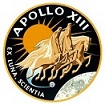
Day 3, part 1: Before the Storm
Corrected Transcript and Commentary Copyright ©2015-2020 by W. David Woods, Johannes Kemppanen, Alexander Turhanov and Lennox J. Waugh. All rights reserved.
Last updated 2020-04-21
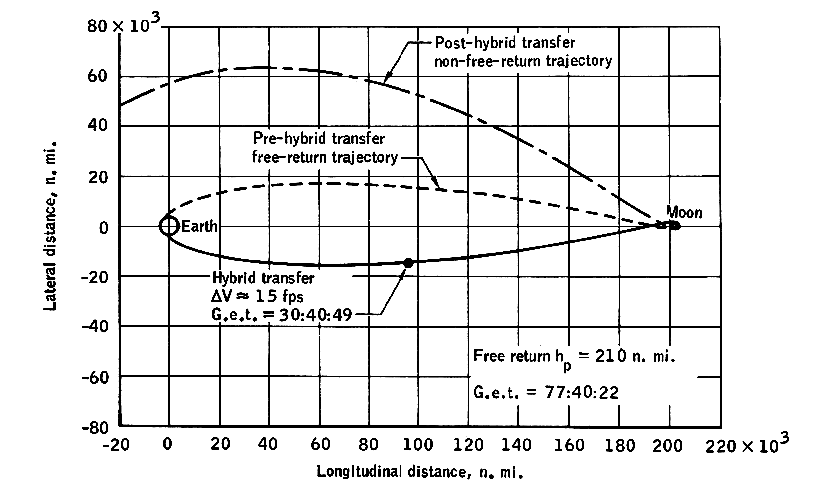
The hybrid transfer trajectory plan.
This is Apollo Control at 38 hours, 8 minutes. The crew is now about one hour into their scheduled ten-hour rest period and here at Mission Control the activity has settled down primarily to watching the spacecraft systems. At the present time Apollo 13 is 140,357 nautical miles [259,941 kilometres] from the Earth travelling at a speed of 4,135 feet per second [1,260 metres per second]. At 38 hours, 8 minutes; this is Mission Control, Houston.
This is Apollo Control of 39 hours, 20 minutes. We're now some 2½ hours into the scheduled 10-hour rest period. The flight surgeon reports that Jim Lovell appears to be sleeping soundly at this time. Lovell is the only crewman who is wearing a biomedical harness, according to the plan. We have almost a little more than 7½ hours remaining in the sleep period. All spacecraft systems continue to function normally at this time. Apollo 13 now 143,222 nautical miles [265,247 km] from Earth and the spacecraft velocity is 4,059 feet per second [1,237 m/s]. At 39 hours, 21 minutes; this is Apollo Control, Houston.
This is Apollo Control at 40 hours. Seven hours remain in the crew's sleep period. Apollo 13 is 144,784 nautical miles [268,140 km] from Earth; velocity, 4,019 feet per second [1,225 m/s]. The latest S-IVB impact time update places impact of the third stage of the booster on the lunar surface at 77 hours, 57 minutes, 4 seconds. Predicted coordinates of impact: 2 degrees, 10 minutes south; 28 degrees, 50 minutes west. This is Mission Control, Houston.
This is Apollo Control at 41 hours. Everything continues to go well aboard Apollo 13 as the three crewmen begin the fifth hour of their scheduled 10-hour rest period. Apollo 13 is 147,103 nautical miles [272,435 km] from Earth. Traveling at a velocity of 3,960 feet per second [1,207 m/s]. This is Mission Control, Houston.
This is Apollo Control at 42 hours. Apollo 13 is now 149,375 nautical miles [276,642 km] from Earth, velocity 3,903 feet per second [1,190 m/s]. The crewmen are at the midpoint now of their 10-hour rest period. That rest period due to end about 47 hours Elapsed Time. This is Mission Control, Houston.
This is Apollo Control at 43 hours. Four hours remains in the Apollo 13 crew's rest period. Spacecraft is 151,625 nautical miles [280,809 km] from Earth, traveling at a velocity of 3,847 feet per second [1,173 m/s]. The Flight Dynamics Officer has again updated the expected S-IVB impact time and coordinates. We are predicting S-IVB impact at 77 hours, 57 minutes, 9 seconds. Coordinates of the impact location on the Moon: 2 degrees, 11 minutes south; 28 degrees, 58 minutes west. News men in the news center can see the impact point in relationship to landing zones on the monitors in the news center at this time. This is Mission Control, Houston.
This is Apollo Control at 43 hours, 17 minutes. Three briefings on future programs are scheduled for this morning in the briefing room at the MSC News Center. Topics and times are Space Station at 9:00 AM, the Space Shuttle at 10:00 AM, and the Reusable Space Tug at 11:00 AM. All three of these briefings will be conducted in the briefing room in the MSC News Center.
This is Apollo Control at 43 hours, 42 minutes. Apollo 13 is 153,172 nautical miles [283,675 km] from Earth, travelling at a velocity of 3,809 feet per second [1,161 m/s]. 3 hours, 17 minutes remains in the crew's rest period. Astronaut Joe Kerwin is the Capcom now. This morning's briefings on future programs in the MSC News Center will be carried on this release line. The first one begins in about 5 minutes at 9:00 AM, CST. The topic of that briefing is Space Stations. This is Mission Control Houston.
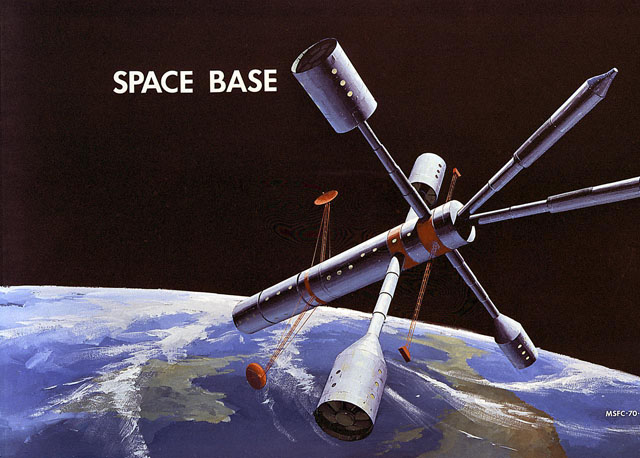
NASA was already investigating future space station concepts to follow up on the also still upcoming Saturn Workshop, aka Skylab.
This is Apollo Control at 44 hours, 42 minutes. Apollo 13's distance now is 155,379 nautical miles [287,762 km], velocity is 3,756 feet per second [1,145 m/s], and 2 hours, 17 minutes remains in the rest period. Mid-course correction number 3 will not be required. Because of this, the plan now is to move the LM activation time and the TV transmission time from the 58 hours under the plan with the mid-course back to 55 hours. LM activation and the TV transmission time will now be at 55 hours Elapsed Time. That's about 8:13 PM CST this evening. The next briefing in the MSC News Room will begin in approximately 5 minutes. The topic will be Space Shuttles, and that briefing will be carried on this line. This is Mission Control, Houston.
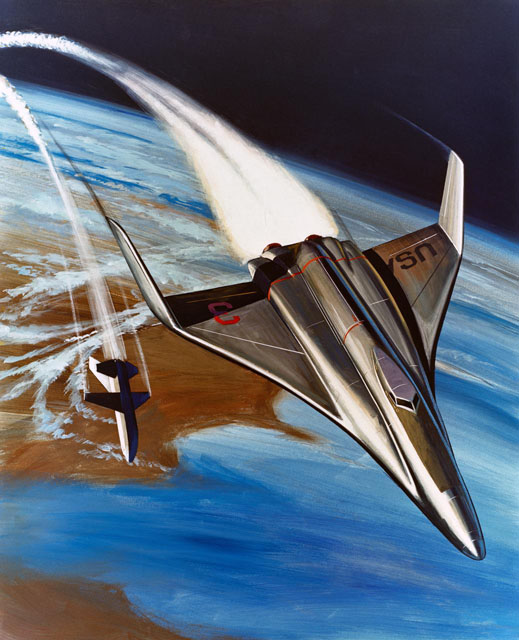
The 1970 space shuttle concept was a fully reusable vehicle that had a piloted booster stage that could fly back to the space center, while the Shuttle continued on to orbit. Both vehicles were to be powered with cryogenic hydrogen/oxygen rocket engines.
This is Apollo Control at 45 hours, 47 minutes. Crew wakeup time is 1 hour, 12 minutes away. Apollo 12 [means Apollo 13] is 157,720 nautical miles [292,097 km] from Earth. Its velocity is 3,701 feet per second [1,128 m/s]. The 11 AM briefing on reusable space tug will be carried on this line. This is Mission Control, Houston.
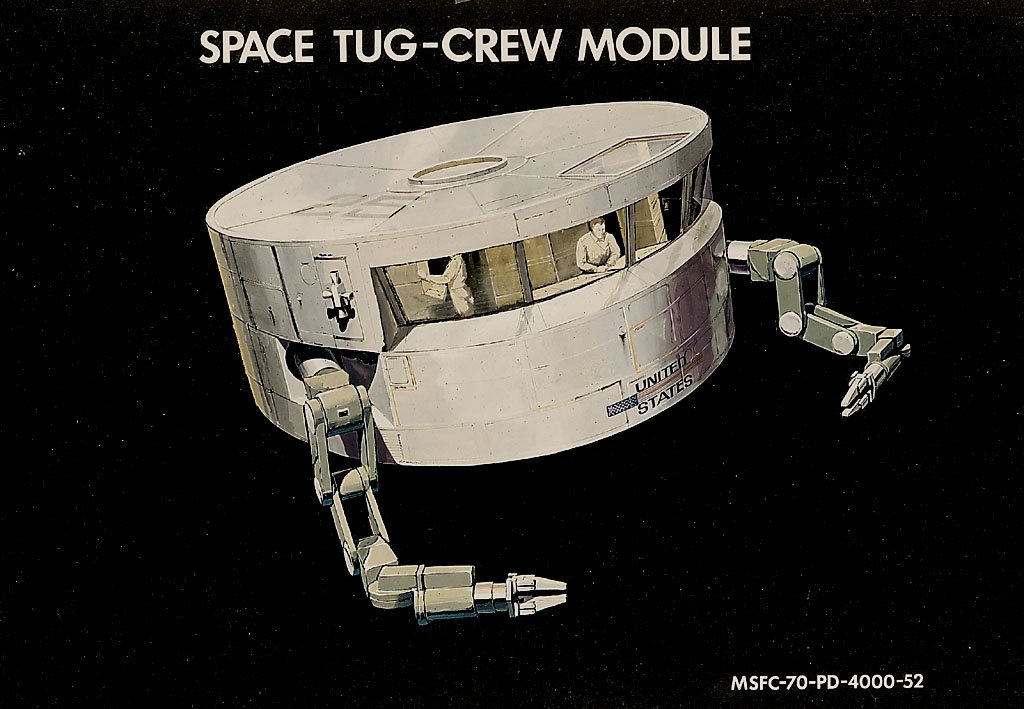
The space tug was envisioned as a multipurpose spacecraft that could perform a wide variety of manned and unmanned missions and reused afterwards. This too, like many other space plans of the time, was only realized as an artist's sketch.
046:43:18 Lovell: Houston, Houston, Apollo 13. Over.
046:43:22 Kerwin: Good morning, 13. You're early.
046:43:27 Lovell: Ah so. I just thought I'd be waking up. And we are awake and getting the spacecraft shipshape. [Garbled]
This is Apollo Control at 46 hours, 43 minutes. Spacecraft Commander Jim Lovell has just put in a call to us 16 minutes prior to wake up time. Here's that conversation.
046:43:38 Kerwin: Roger. Spacecraft is in real good shape as far as we're concerned, Jim. We're bored to tears down here. We do have a few little items for you, like a P37 update and a couple of Flight Plan updates. But there's no rush about them. Over.
046:43:56 Lovell: Okay. Gig us again in a few minutes. We're breaking out some food, and we'll copy them then.
046:44:01 Kerwin: Okay. And the Surgeon will be ready for your sleep report whenever you get that together.
046:44:08 Lovell: Righto. If he's listening, LMP had a solid 9 hours of sleep; I couldn't wake him up this morning. The CMP had 6 hours, and the Commander about 5 intermittent.
046:44:22 Kerwin: Okay...
046:44:24 Lovell: Jack's dosimeter - Jack's dosimeter is reading 02026.
046:44:32 Kerwin: Okay. We got it.
046:44:36 Lovell: It might be interesting that just after we went to sleep last night we had a Master Alarm and it really scared us. And we were all over the cockpit like a wet noodle.
046:44:45 Kerwin: (Laughter) Sorry it wasn't something more significant. I've also got a procedure for you on that H
2 tank; simple thing after you get done stirring up the cryos.
046:46:56 (Music - With Their Eyes on the Stars)
046:47:10 Kerwin: That was beautiful. What was it?
046:47:16 Lovell: A little of 'With Their Eyes on the Stars' to wake up to.
046:47:24 Kerwin: Sounds like all the comforts of home. Have you guys got a flower on your breakfast table?
046:47:33 Lovell: Yes. Jack!
The CapCom is astronaut Joe Kerwin. With him at his console is the backup crew commander John Young.
Apollo 13 is 159,967 nautical miles [296,259 km] from Earth; velocity, 3,649 feet per second [1,112 m/s].
The Flight Dynamics Officer has again updated the S-IVB impact time and location. Impact time; 77 hours, 57 minutes, 5 seconds. Coordinates: 1 degree, 54 minutes south; 28 degrees, 47 minutes west.
047:38:10 Lovell: Houston, Apollo 13. Over.
047:38:13 Kerwin: 13, Houston. Go ahead. [Pause.]
047:38:24 Kerwin: 13, this is Houston. Go.
047:38:28 Lovell: Roger, Joe. We're standing by for that P37 block data if you have it for us.
047:38:32 Kerwin: Okay. Got it right here, Jim, and it follows. This is the P37 PAD for lift-off plus 60. The reason for the update is for weather avoidance in the MPL at 119 hours. It's the same one we passed you yesterday, and it's the same weather, but we still don't expect a problem at the end of the mission. GET
I is 060:00; Delta-V
T, 6,079; longitude, minus 153; GET 400K, 118:04. Over.
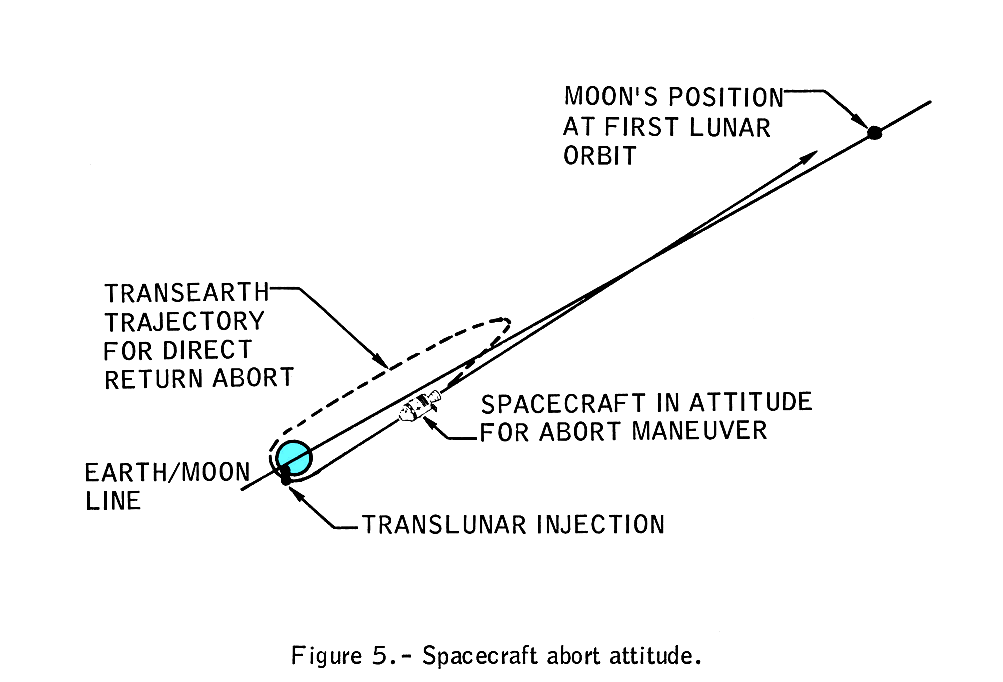
Translunar abort profile. Apollo 13 Lunar trajectory notes.
047:39:18 Lovell: GET
I of 060:00, 6079, minus 153, 118:04.
047:39:29 Kerwin: Roger. That's correct. I've got a consumables update for you, Jim, if you're ready for that. [Pause.]
047:39:41 Lovell: Ready to copy.
047:39:43 Kerwin: Okay. As of 47 hours; RCS total, 1,096; quad Alpha, 270; Bravo, 278; Charlie, 270; Delta, 278; and the H
2 - They gave me the H
2s in percent, 76 percent; and on the O
2 we have 81 percent. However, we show the O
2 tank 2 reading off-scale high now. We're quite sure it's a sensor failure. We'd like you to verify it with your onboard reading.
047:40:29 Lovell: Okay. Stand by. [Long pause.]
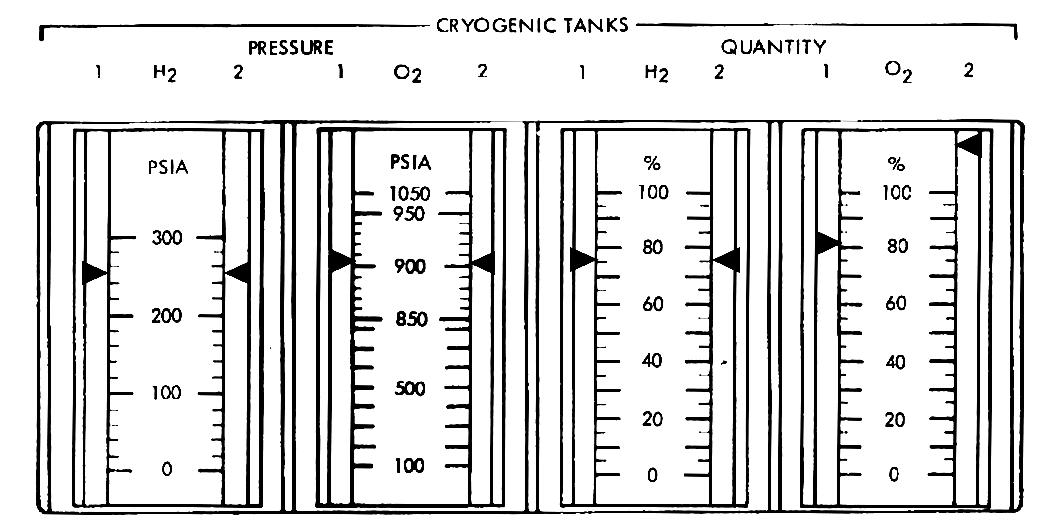
Cryo pressure and quantity measurements, as seen onboard at this time. Recreated based on transcript.
047:40:47 Lovell: Joe, we confirm. Our gauge reading is - on the number 2 O
2 tank is reading off-scale high now, but Jack just tells me that it was okay when we first looked at it this morning.
047:41:00 Kerwin: We verify that. At 46:45 we had 82 percent and apparently when he stirred the, the cryos, the sensor broke.
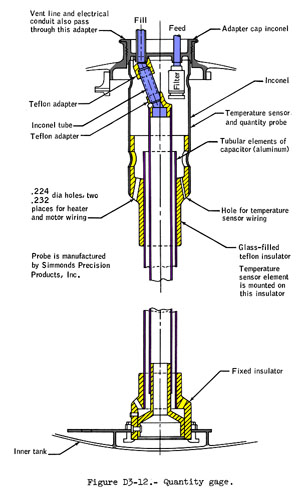
Diagram of the capacitor tube-within-a-tube quantity sensing arrangement within the cryogenic storage tanks.
047:41:19 Kerwin: So it's no problem. You're above nominal on all your consumables. On the H
2 tank problem, we have a procedure that we'd like you to carry out which is simply turning the H
2 tank 2 heaters to Off at this time, and we want to see whether that won't solve the problem of the tank pressure setting off caution and warning. We want to look at it that way for a few hours.
047:41:47 Lovell: Okay. You want both H
2 tank 2 heaters to Off. Is that correct?
047:41:51 Kerwin: That's negative; just tank 2. We want tank 1 to stay in Auto.
047:41:57 Lovell: Okay. Tank 2 heaters Off at this time.
047:42:00 Kerwin: Okay. Good deal. That's been the high tank and apparently while waiting for that pressure switch to close, to start the heater cycle, the tank 1 pressure has been dropping even a little bit lower and just setting off caution and warning, so we feel if we turn off the tank 2 heater and let tank 1 activate the heater cycle, we won't get into the caution and warning range.
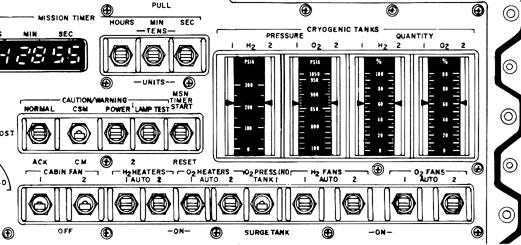
Cryogenic tank pressure and quantity gauges as well as the switches for controlling the fans and heaters in Auto and manual modes. Original scan via heroicrelics.org
047:42:26 Kerwin: Okay, Jim. At your convenience we'd like P00 and Accept. We're ready for - to uplink your state vector now since we will not do midcourse 3. Over.
047:42:38 Lovell: Roger. You're in P00 and Accept, no midcourse 3, and we're all set for a state vector update and I'm giving you the LM/CM Delta-P here shortly.
047:42:46 Kerwin: Okay. Good deal. And I have Flight Plan updates for you later, at your convenience. [Long pause.]
047:43:18 Lovell: Houston, Apollo 13. The LM/CM Delta-P is 1.0 psi.
047:43:23 Kerwin: Copy, 1.0, Jim.
047:44:37 Lovell: Houston, Apollo 13. I'm about ready for any Flight Plan updates that you have.
047:44:40 Kerwin: Okay, 13. To start off with, got a minor procedural change for Jack on his next P52, if he's ready to listen to that.
047:44:54 Lovell: Okay. Jack's still off comm. We'll hold off on that a little bit and then we'll pick it up when he gets on comm.
047:45:01 Kerwin: Okay; fine. I've got two updates for you, Jim. One is a procedure for looking for Comet Bennett at about 49:45, and I'll wait till Jack gets up before passing you the details on that. The other update is concerned with going into the LM three hours early, and I think Vance mentioned to you last night that this was a possibility, that we'd like to look at the SHe tank pressure early. And since we're not going to do midcourse 3, we'd like LM entry at 55 hours. Is that okay with you?
047:45:41 Lovell: Okay. Right, that's fine with us. We'll move up LM entry to 55 hours.
047:45:48 Kerwin: Okay. I've got some details on the Flight Plan for you as follows. Of course, since there's no MCC-3, you'll be deleting all the midcourse 3 stuff including the - the P52, which is called out at about 54½, and we'll be slipping that until later, which I'll - which I'll tell - which I'll tell - which I'll tell you in a minute. Okay. Then you - we want to move the battery charge up three hours to about 52:30. And we want to move the - moving the LM tunnel vent valve to LM/CM Delta-P up three hours to 52:45, and at that point you can simply go to the 57-hour point in the Flight Plan and change your number from 57 hours to 54 hours and start through that. In the remarks section at about 57:50 it says, 'O
2 fuel cell purge and waste water dump,' here. If not performed earlier, we want you to do that at 54 hours and 50 minutes. The TV pass then, will be at 55 hours to 55:30. You'll go right through the LM Activation checklist stuff. I'm losing you; let's wait a minute. [Long pause.]
047:47:41 Kerwin: 13, Houston. How do you read me? [Long pause.]
047:48:05 Kerwin: 13, Houston. You back with us?
047:49:14 Kerwin: Apollo 13, Houston. Are you back with us?
047:49:19 Lovell: We're back with you.
047:49:20 Kerwin: Okay. I've gone through the battery charge, the LM vent valve, the fuel cell purge, and then stop PTC at 55 hours, and your roll attitude there will be 285 degrees, which is per the Flight Plan. The High Gain Antenna angles are slightly different, pitch 23 and yaw 267 degrees. The TV pass till 55:30, the standard LM activation except for some special steps we'll give you to take a look at SHe tank pressure, which I don't have yet. Restart PTC at about 56:30 or whenever you're through with the LM activities, and after that, at your convenience, we'd like you to - to do the P52 option 3 that we cancelled at 54½ hours. Over. [Pause.]
047:50:27 Lovell: Okay. That last comment was that we'll do the P52 after we start PTC at about 56:30.
047:50:31 Kerwin: That's right. Any time after that; it's not time critical. [Pause.]
047:50:43 Lovell: Okay. Let's see if I have some of this, Joe. Around 52:30 we're to do the battery charge on Bat - battery B.
047:50:52 Kerwin: That's correct.
047:50:54 Lovell: And then about 52:40 we're going to do the LM tunnel vent valve, and the LM/CM Delta-P which has been written up at 55:40.
047:51:04 Kerwin: That's correct.
047:51:09 Lovell: We're deleting midcourse-3 and we've moved up the LM entry to 55 hours. So we'll merely follow all the - We'll follow all the procedures that leads up to LM entry that was originally scheduled for 58.
047:51:29 Kerwin: That's correct. You can start at 57 in the Flight Plan; call it 54 hours and press right on. [Pause.]
047:51:48 Lovell: Okay. Then whenever we're finished with the LM, which we anticipate around 56:30, we'll commence PTC and sometime after that we'll do a P52. [Pause.]
047:51:59 Kerwin: That's affirmative. And did you copy the new High Gain angles for 55 hours? The ones we had... [Pause.]
047:52:12 Lovell: Okay. We're going to stop the PTC for LM entry at roll 285, and High Gain angles are pitch 23 and yaw 267.
047:52:23 Kerwin: That's correct, Jim. And, 13, Houston. The computer is yours.
047:52:35 Lovell: The computer is ours. We're in Block, and exactly when do you want the TV to be cranked up?
047:52:41 Kerwin: You can crank it up sometime prior to 55 hours at your convenience just to set it up. We'll be expecting transmission at 55 hours.
047:52:55 Lovell: Okay. [Long pause.]
047:53:46 Lovell: And, Houston, Apollo 13. One thing I missed about the O
2 fuel cell purge and waste and water dump.
047:53:53 Kerwin: Roger. We'd like the O
2 fuel cell purge and waste water dump at 54:50.
047:54:04 Lovell: Roger. We'll pick up those items at 54:50. [Long pause.]
047:54:30 Kerwin: Apollo 13, Houston.
047:54:35 Swigert: Go ahead, Joe.
047:54:36 Kerwin: All right, Jack. One thing we'd like to have done sometime soon is to have you cycle the cryo fans in O
2 tank 2 one more time. We'd like to see if we can get that sensor back.
047:54:50 Haise: Okay. O
2 tank 2 fan on now.
047:56:08 Lovell: Houston, 13.
047:56:09 Kerwin: Go, 13.
047:56:14 Lovell: We - We have just one question, the LM tunnel vent valve. We're questioning why we're venting until the Delta-P is greater than 1.7 if we are going to open up the tunnel, then pressurize the LM usually.
047:56:27 Kerwin: Right. Stand by on that. [Long pause.]
047:56:51 Kerwin: 13, Houston.
047:56:55 Lovell: Go ahead.
047:56:56 Kerwin: Roger. The word on that, Jim, is that they want to ensure the proper O
2 concentration in the LM when you get to the surface, and this is a method of doing that by bleeding out additional nitrogen.
047:57:12 Lovell: Okay. Thank you. [Pause.]
047:57:21 Kerwin: And, 13, Houston. If Jack is up, I'd like to talk to him about the P52, briefly.
047:57:29 Lovell: Okay. He's here.
047:57:31 Swigert: Go ahead, Joe.
047:57:32 Kerwin: Okay, Jack. What they'd like you to do on this P52 at 49 hours, they've been observing a slight jitter in the optics shaft angle of about 0.2 of a degree plus or minus. Before you come out of the Optics zero position, at the start of this P52, they'd like you to just observe the shaft readout, and see if the jitter occurs on your direct readout there, and also they'd like you to briefly call up a Verb 16, Noun 91 so we can look at the shaft and trunnion angles.
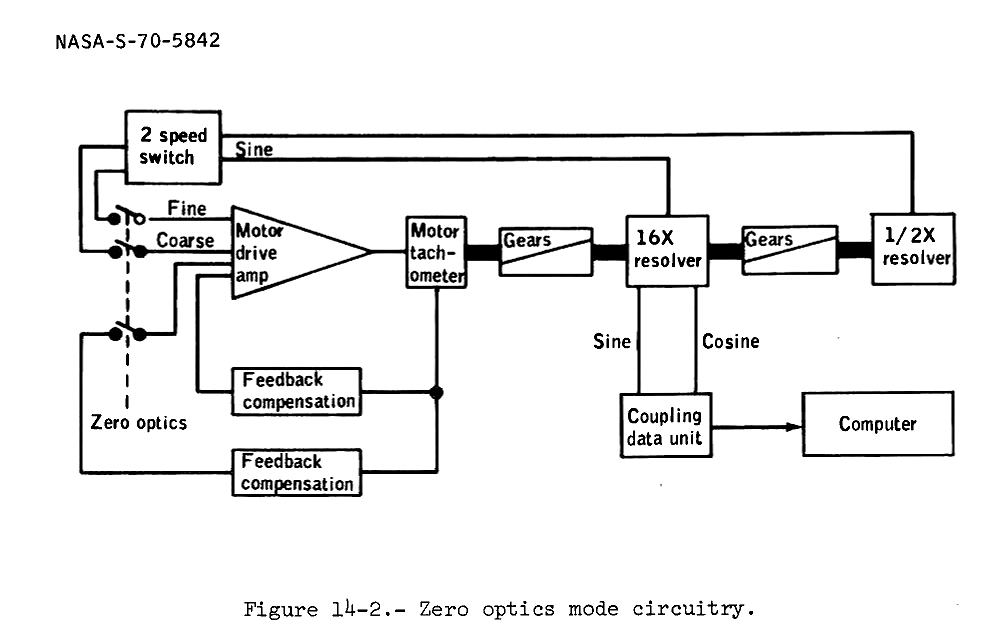
Diagram of the optics drive train. From the Apollo 13 Mission Report.
047:58:11 Swigert: Okay. Let's see if I got it right. On the P52 at 49 hours, before coming out of zero on the Optics, observe the shaft and also call up 16, 91 and let you look at the shaft and trunnion angles to observe a possible jitter. See whether it occurs in the zero position as well as out of zero.
047:58:33 Kerwin: Roger, Jack. That's correct; and if you have time, now, I've got a Flight Plan update for you on looking for the Comet Bennett. [Pause.]
047:58:50 Swigert: Okay. Stand by one, Joe. And the commander's going off the air briefly.
047:58:58 Kerwin: Roger that.
048:00:02 Swigert: Okay, Joe. I'm ready to copy the [garble] now.
048:00:04 Kerwin: Okay, Jack. I'm going to read it to you, and then add some comments and we'll talk about it a little. This should occur sometime after 49:30. After the P52 realign at 49 hours, if time permits, we would like the crew to investigate while in PTC if there is a roll angle in which the comet can be observed for photos. If there is, record the optimum roll angle for possible photography, prior to reinitiating PTC at 56:30 or so, whenever the guys are done in the LM, use P52 planet option, and the following half-unit vectors for tracking Comet Bennett at about 49:46. Are you ready to copy half-unit vectors? Over.
048:01:05 Swigert: Okay. Go ahead, Joe.
048:01:07 Kerwin: Okay. R1, plus 0.34202; R2, minus 0.07374; R3, plus 0.35719. Read back. [Pause.]
048:01:33 Swigert: Okay. Copy. R1, plus 0.34202; R2, minus 0.07374; R3, plus 0.35719.
048:01:48 Kerwin: Okay. That's correct and the last sentence on the update is that you can expect AOS of the comet at a roll of 45 degrees and LOS at a roll of 155 degrees. Now, the deal here, Jack, according to the plots they showed me is, the comet appears to be about 10 degrees away from the Sun, and due to the geometry of the LM there shadowing the Sun, it would appear that you will be able to see the comet through the sextant without getting Sun shafting between roll angles of about 45 degrees and 75 degrees. It appears that as your roll gets higher than 75 degrees, although the comet is still in the field of view, the Sun is also in the field of view, and you probably will not have any success between 75 and 155 if you haven't got it from 45 to 75. If you do find that you can see the comet somewhere between 45 and 75 or 80 degrees, just note that roll angle and then if it's feasible we'd like you to photograph it after the LM entry part of the checklist. Over.
048:03:10 Swigert: Okay, Joe. Let me give it back to you and see if I've got it here. After the P52, during our PTC you want us to use P52 and observe Bennett's Comet through the sextant; note a roll angle if we can find it visible. It would be visible somewhere between - ideally between 45 and 75 degrees, and we should lose it about 155 roll, and if we do see it, make an observation of whether it is photographable, note the roll angle for photographs to be taken after or prior to initiation of PTC at 56:30.
048:03:58 Kerwin: That's exactly right, Jack.
048:04:04 Swigert: Okay. Real fine.
048:06:20 Kerwin: Apollo 13, Houston.
048:06:24 Swigert: Go ahead, Joe.
048:06:25 Kerwin: We're ready to have to O
2 tank 2 fan off, and thank you.
048:06:32 Swigert: Okay. Doesn't look like we got it back, huh?
048:06:35 Kerwin: No, it doesn't, Jack.
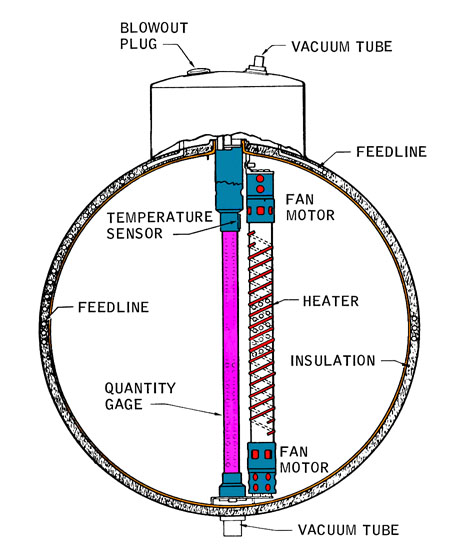
Cross-section of an Apollo oxygen tank
At 48 hours, 32 minutes, Apollo 13's distance is 163,513 nautical miles [302,826 km]; velocity, 3,568 feet per second [1,088 m/s].
This is Apollo Control at 48 hours, 48 minutes. At the Control Center, the Gold team, led by Gerry Griffin, is in the process of turning over to Gene Kranz and his White team. We're estimating a change of shift News Conference with Gerry Griffin for 2:30 PM CST in the briefing room at the MSC News Center.
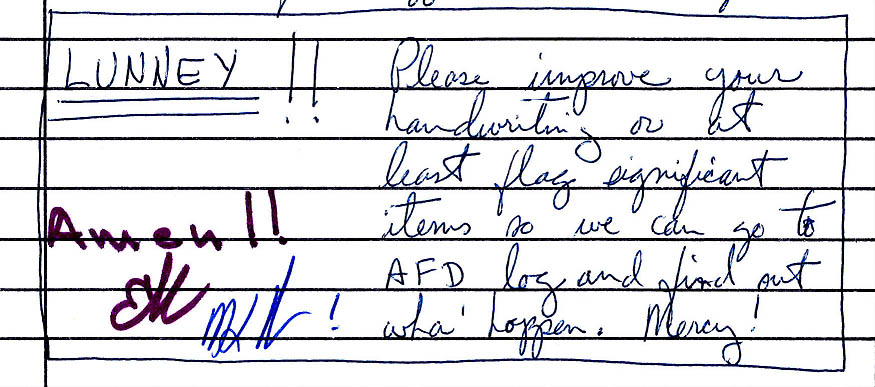
A remarkable note in the Flight Director's Mission Log, chastising Glynn Lunney's penmanship.
049:01:01 Swigert: Houston, Apollo 13. [Long pause.]
This is Apollo Control Houston at 49 hours, 1 minute now into the flight of Apollo 13. The Apollo 13 spacecraft...
049:01:20 Swigert: Houston, Apollo 13.
049:01:22 Kerwin: Hey, 13; Houston. Go ahead.
049:01:26 Swigert: Okay, Joe. I've started into P52 here. I've proceeded on option 3, and on the dis - 1520 - 1525 display, I've called up 16 91. I'm going to let you observe and see while the - the shaft angle while the Optics are still in zero.
049:01:47 Kerwin: Okay. Roger that, Jack. We're looking at it, and I'll give you a mark as soon as G&C is happy. [Pause.]
049:01:55 Swigert: Okay. Real fine. [Long pause.]
That was Jack Swigert, Command Module Pilot. He's aligning his spacecraft platform at this time.
049:02:26 Kerwin: 13 Houston. Jack, could you give us a readout on your counter now?
049:02:35 Swigert: Okay. I'm showing a shaft of 0.2 and a trunnion of 359.92.
049:02:48 Kerwin: Roger. Copy that. Is there any jumping around on the shaft?
049:02:57 Swigert: You mean on the TPAC readout?
049:03:02 Swigert: As a matter of fact, it went from 0.2 to 0.21.
049:03:08 Kerwin: Okay. Copy that. Stand by one.
049:03:13 Swigert: Okay. Now it went down - It went down as low as 0.15.
049:03:18 Kerwin: Okay. [Long pause.]
Apollo Control, Houston. Apollo 13 now 164,602 nautical miles [304,843 km] away from Earth, traveling at a speed of 3,544 feet per second [1,080 m/s].
049:04:09 Kerwin: Jack, Houston. Let us watch that for another minute or so.
049:04:15 Swigert: Okay. I'm in no hurry. It looked like it burned between 0.14 and 0.8 with an occasional spike up to 0.2.
049:05:30 Kerwin: Apollo 13, Houston. [Long pause.]
049:06:04 Kerwin: Apollo 13, Houston. You can press on with P52 now. Over.
049:06:10 Swigert: Okay, Joe.
This is Apollo Control, Houston. In the Mission Control Center, Gene Kranz is taking the reins of the flight control team. He's sporting a flashy white vest in the best traditions of his team color. Joe Kerwin remains on as the Capsule Communicator with the spacecraft. We are at 49 hours, 6 minutes into the flight and Apollo 13 is presently 164,698 nautical miles [305,020 km] out from Earth, traveling at a speed of 3,541 feet per second [1,079 m/s]. This is Apollo Control, Houston.
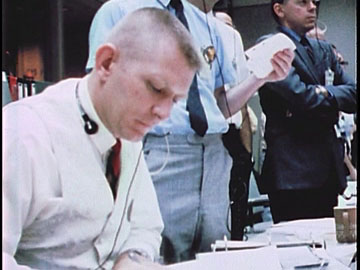
Gene Kranz deep at work at his Flight Control station, wearing his signature vest.
049:08:17 Swigert: Hey, Houston, are we clear to torque? Are you reading the torqueing angles? [Pause.]
049:08:28 Kerwin: 13, Houston. Go ahead and torque.
049:08:35 Swigert: Okay. Time of torqueing will be 49 hours, 8 minutes, 35 seconds.
049:08:41 Kerwin: Roger that.
This is Apollo Control Houston at 49 hours, and 9 minutes into the flight, the change of shift news conference is still estimated - has an estimated start of 2:30. Meanwhile in Mission Control, Flight Dynamics has updated our S-IVB impact coordinates in time. We are presently looking at coordinates of 2 degree, 18 minutes south; 28 degrees, 55 zero [sic] minutes west at a Ground Elapsed Time of 77 hours, 57 minutes, 5 seconds. Apollo 13 is now 164,814 nautical miles [305,236 km] away from Earth, traveling at a speed of 3,539 feet per second [1,079 m/s].
049:10:13 Kerwin: Apollo 13, Houston.
049:10:17 Lovell: Go ahead, Houston.
049:10:19 Kerwin: Roger. For Jack, we missed the star angle difference on the P52. Would you read us that?
049:10:30 Lovell: Roger, Houston. It was all balls.
049:10:32 Kerwin: Okay. Thank you.
That was Jim Lovell, Spacecraft Commander, responding to Joe Kerwin. We are at 49 hours, 11 minutes now into the flight, and this is Apollo Control, Houston.
This is Apollo Control, Houston. 49 hours, 15 minutes now into the flight. We'll take down our air-to-ground line at this time since the change of shift briefing is now scheduled to begin. This is Apollo Control, Houston.
This is Apollo Control Houston, 49 hours, 32 minutes now since lift-off. Apollo 13 presently 165,573 nautical miles [306,641 km] out from Earth, traveling at a velocity of 3,522 feet per second [1,074 m/s]. Since we took the line down for the change of shift briefing, we've had no voice communications with the crew, however, we will leave the line open at this time and stand by and continue to monitor. At 49 hours, 33 minutes into the flight; this is Apollo Control, Houston.
This is Apollo Control, Houston at 49 hours, 35 minutes since lift-off. We are presently looking at the start of LM activation at 55 hours, Ground Elapsed Time, and Goldstone will be feeding the TV transmission at that time. Apollo 13 now 165,675 nautical miles [306,830 km] away from Earth, and traveling at a speed of 3,520 feet per second [1,072 m/s]. We are 49 hours, 36 minutes; and this is Apollo Control, Houston.
049:42:38 Swigert: Hey, Houston; 13.
049:42:40 Kerwin: 13, Houston. Go ahead.
049:42:44 Swigert: Okay, Joe. I got into P52 about 49:34. We loaded the planet - or Bennett Comet vectors into the planet option, and P52 tracked it all the way across except that it was always occulted by the LM, and we're in a roll angle of 155 now.
049:43:09 Kerwin: Roger. We're copying your roll angles. At what roll angle were you able to start tracking it, Jack? [Pause.]
049:43:24 Swigert: Okay. At the time we entered it there, we were about 66 degrees roll, so either we started too late, or maybe somehow we got a wrong calculation on the roll angle.
049:43:40 Kerwin: Okay. Let me have G&C comment on that. I suspect that the roll angles we gave you were calculated for exactly 90 degrees pitch, and you're probably wobbling enough that they're not exactly correct.
049:44:02 Lovell: Yes, I think you - You probably got the right idea.
049:45:24 Kerwin: 13, Houston. Over.
049:45:29 Swigert: Go ahead.
049:45:30 Kerwin: Okay, Jack. Notice you've secured from that, and that was going to be our recommendation, anyway. We're going to have the guys in the back room look at it and see if they can come up with some - with some better numbers based on the cone angle that - that you're traveling through, whether there are any roll angles that - that are available to you. And if there are, and we have time, we might give it another try; if not, we just will forget it.
049:48:17 Kerwin: Apollo 13, Houston. Over.
049:48:22 Swigert: Go ahead, Joe.
049:48:27 Kerwin: Okay, Jack. I'd like to pass you a switch configuration on the Cryo O
2 tanks and give you the reason. Right now, we'd like you to go to Heaters tank 1, Off; tank 2, Auto, which is the opposite of the way you've got them now. Over.
049:48:48 Swigert: Okay. Is this O
2 or H
2?
049:48:51 Kerwin: This is O
2, and stand by for a minute and we'll have a - Excuse me. This is H
2, Jack; it's H
2. [Long pause.]
049:49:22 Swigert: [Garble] is Auto, [garble] 2 Off. [Long pause.]
049:49:52 Swigert: Okay, Joe. Do we have you back again?
049:49:55 Kerwin: Okay, Jack. We're getting you back, and I hope you copied my - my correction of my mistake. I'm talking about the H
2 Cryo Tanks. We'd like the tank 1 Heater to Off; tank 2 to Auto. Over.
049:50:09 Swigert: Okay. We lost you again. Here's our heater configuration now. H
2 Heaters 1, Off; 2, Auto. Both O
2 Heaters are in Auto. [Long pause.]
049:50:23 Kerwin: Okay. That's the configuration we want you in, and here's what we're thinking about. When we went to tank 1 Auto, tank 2 Off; we found that the heater cycle had a tank 1 pressure of about 233 psi, which is well above the caution and warning limit, and if we go to that configuration for sleep, we'll keep from getting Caution and Warning lights during the sleep cycle. Okay. In order to do that comfortably, we want to spend the rest of the day using more H
2 out of tank number 2, so as to get an unbalance in favor of tank 1, so at the end of the sleep cycle it'll all come out even. And that's why we have you in tank 1 Off, tank 2 Auto, now. We expect to get about a 3-percent unbalance over the next 10 hours; and prior to sleep, we'll call you to reverse the configuration again. Now the only disadvantage here is that, during the day, you will probably get a few Caution and Warnings, and we just figured it would be better to get them now than while you were sacked out. Over.
049:51:35 Lovell: I'll buy that 100 percent.
049:51:37 Kerwin: Okay. Good deal. One other detail for you, Jack; G&C tells us that the Optics jitter is very similar to what we had on Apollo 12. It's no problem, but when you're not using the Optics, we recommend that you turn the Optics Power switch to Off to guard against a possible degradation as the flight progresses. Over.
049:52:09 Swigert: Okay. Will do. [Long pause.]
049:52:23 Kerwin: Okay. Apollo 13, Houston. I have one more little update for you, and it's another update to the erasable memory onboard crew charts on page G/9-2. Over. [Long pause.]
049:52:48 Lovell: Houston, 13. We're ready to copy.
049:52:51 Kerwin: Okay, Jim. These are gyro compensation terms. They've already been uplinked, and we're just updating your onboard charts now. In column A: number 11, change from 77646 to 00114; number 12, change from 77332 to 77546; number 13, change from 76617 to 77201. Over.
049:53:43 Lovell: The changes are as follows, and all in column A: number 12, the new change is 77546; number 11, the new change is 00114; and 13, the new change is 77201. Over.
049:54:01 Kerwin: Roger. Readback correct.
049:54:06 Swigert: And, Joe, do you know - Are you going to try and let us spot the Bennett Comet on this next revolution there? Or do you want me to turn the Optics power off now?
049:54:17 Kerwin: Stand by one, Jack. Okay, Jack. We don't have confidence in those roll angles yet, so why don't you turn the Optics off, and we'll update you later.
049:54:32 Swigert: Okay. Going off now.
This is Apollo Control, Houston; at 49 hours, 55 minutes now into the flight. Apollo 13 now 166,341 nautical miles [308,064 km] away from Earth, traveling at a velocity of 3,505 feet per second [1,068 m/s]. What you heard, was a relatively long exchange between capsule communicator Joe Kerwin and both Command Module Pilot Jack Swigert and spacecraft commander Jim Lovell. The Auto and Off heater positions referred to are the switch positions for the H2 heater used to control redundant heaters in the two cryogenic hydrogen tanks. We are at 49 hours, 56 minutes into the flight and continuing to monitor. This is Apollo Control, Houston.
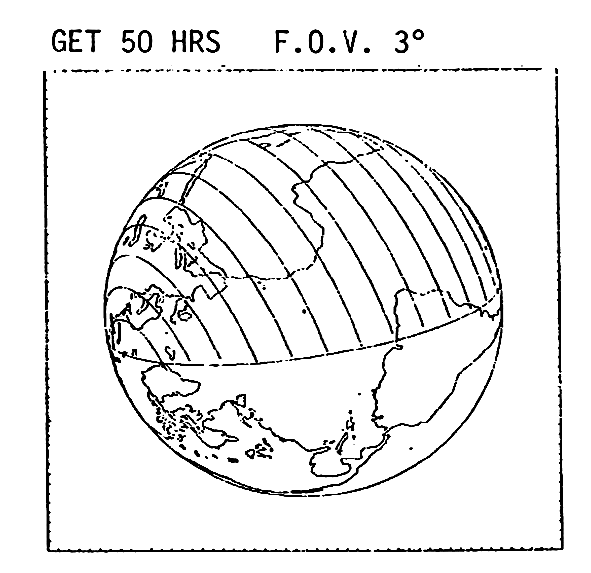
Computer-generated view of how Earth would have appeared during 50 hours GET.
This is Apollo Control Houston at 50 hours, 09 minutes into the flight. We presently show Apollo 13 at an altitude of 166,801 nautical miles [308,915 km], now traveling at a speed of 3,495 feet per second [1,065 m/s].
This is Apollo Control, Houston; at 50 hours, 25 minutes now into the flight. Our display presently shows Apollo 13 at 167,355 nautical miles [309,941 km] away from Earth, and traveling at a speed of 3,483 feet per second [1,062 m/s]. We've had no voice communication with the crew for the past 15 or so minutes, however, we will standby and continue to keep the line open and alive. We're at 55 hours, 25 minutes [means 50 hours, 25 minutes]; and this is Apollo Control, Houston.
050:26:48 Kerwin: Apollo 13, Houston.
050:26:53 Swigert: Go ahead.
050:26:54 Lovell: Go ahead, Houston.
050:26:55 Kerwin: Roger, Jim. If you've got a couple of minutes now, I'd like to read up to you the change to the LM entry procedure that we'd like you to observe at 55 hours, and the rationale for it. Over.
050:27:14 Lovell: Okay, Stand by.
050:27:23 Lovell: Go ahead, Joe.
050:27:25 Kerwin: Okay. Before you start copying, this procedure is - is basically simply to activate the supercritical helium pressure gauging so that you can read it. And the concern here is lest this supercritical helium pressure reach 1800 psi by 103 hours, at which point we'd be within a possibility of rupturing the burst disk when you activate the DPS. Now, based on the pressure at launch, and based on a nominal rise time of about 6½ psi per hour between then and now, the pressure should read about 710 psi. Stand by, 13, until we get better comm. [Long pause.]
050:28:43 Lovell: Houston, you were cut out. Would you say again about the helium pressure.
050:28:49 Kerwin: Roger. Based on the prelaunch pressure in the SHe tank and the nominal rise time of about 6½ psi per hour, the pressure should be about 710 at 55 hours. Are you reading? Over. [Pause.]
050:29:16 Kerwin: Jim, Houston. Did you read that last?
050:30:43 Haise: Okay, Joe. I'm on Omni C now. How do you read?
050:30:47 Kerwin: 13, Houston. You're loud and clear now. INCO tells me he's having a little problem at Goldstone and wants me to stand by for a minute. [Pause.]
050:31:02 Haise: Okay. How do you read now, Joe? I'm going from Omni C to D now.
050:31:06 Kerwin: You're still loud and clear on - on D, Fred. Stand by one.
050:31:14 Haise: Okay. I'll put her back to Omni B if you all want to take command again? [Long pause.]
050:31:49 Haise: And the last thing we heard, Joe, was that the Supercrit should be reading about 710 psi.
050:31:56 Kerwin: Okay. That's the last thing I passed up. And while we're waiting for INCO to decide here, let me continue. The dead band that is considered acceptable is between 660 and 770 psi. In other words, any rise time that'll give you one - a pressure between those two, will keep you below the critical pressure at 103 hours or so. So, we expect it to read in that - in that band and if it does, there will be no problem. If it reads between 770 and 800 psi, we will want you to check the pressure again at about 59 hours, and I'll get the detailed procedures in a minute. If the pressure is equal to or greater than 800 psi, we're going to have to go into some more detailed procedures; we're going to try to - to get PCM data on it, for one thing. We may have to have you sit there and stare at the gauge for a while to find out when it clicks up and get an accurate rise time on it, and then in extreme case, we are even thinking about a DPS burn, but we don't really think that will happen. Now, if you are ready to copy, what I have for you is a change or an addition to the LM Activation checklist between pages TLC-1 and TLC-2, which consists of seven steps, and if you can find a blank side to write it down on, I would like to pass it up. Over. [Long pause.]
050:33:44 Haise: Okay. How do you read on Omni C, now?
050:33:48 Kerwin: Okay. You're loud and clear on Omni C. Stand by one while we get INCO synced up. [Pause.]
050:34:00 Haise: Okay. The rest of your update was that it's okay if it is anywhere between 660 and 770 psi. If it's above 770, you are going to ask us to consider going back in at 59 hours and either get PCM going or sit there and give you gauge reading changes on the basis of that. And you said something about an extreme measure; we may have to consider some sort of DPS maneuver.
050:34:45 Kerwin: That's correct, Fred. We don't have procedures for that yet, and we don't have any real expectation of getting into it. The procedure I'd like to read up to you now is simply the steps required to get the supercritical helium pressure reading, at 55 hours. Over.
050:35:12 Kerwin: Okay. We're calling this TLC1-A, step 6, 'Transfer to LM power.'
050:35:23 Haise: All right. Stand by one, Joe.
050:35:25 Kerwin: Okay. [Pause.]
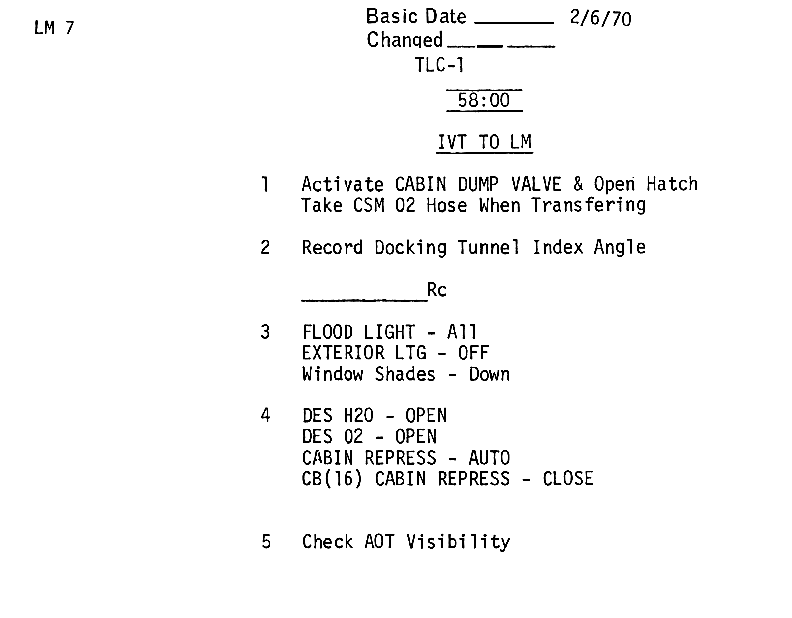
Page TLC-1 from the Lunar Module Activation Checklist.
050:35:37 Swigert: Okay, Joe. He's ready to copy.
050:35:40 Kerwin: Okay. Step 6, 'Transfer to LM power (floodlights blank), Caution Warning Power Caution light On. Report GET to MCC. Panel 11, Circuit Breaker EPS Translunar Bus Tie, Closed. Circuit breaker panel 16, EPS Translunar Bus Tie, Closed. Circuit breaker panel 11, Lighting Utility, Closed. And activate utility lights.'...
050:36:33 Haise: Stand by, Joe.
050:36:35 Kerwin: Over. And, 13, Houston. Select Omni Bravo, please. [Long pause.]
050:37:08 Haise: Okay, Joe. I've created a new page here called TLC-1A, item 6, Transfer to LM power and the usual check that the floodlight's blank and that I've got the Caution Warning Power light On; I get a GET from Jack, and I will pass that on down to you. Item 7, Circuit Breaker EPS Translunar Bus Tie, panels 11 and 16, Closed. Step 8, circuit breaker lighting and utility on panel 11, Closed, and turn on the utility lights. However, the lighting is such that I don't really need those. They are in stowage, right now, I guess, in the ISA, and I'll probably just leave them there.
050:37:48 Kerwin: Okay. That's optional. The way we had page TLC-1A written, that was all part of step 6. You haven't even gotten to step 7 yet. Step 7 is as follows. [Pause.]
050:38:11 Kerwin: Fred, Houston. Are you with me? [Long pause.]
050:38:41 Kerwin: Apollo 13, Houston. Are you reading me now?
This is Apollo Control, Houston.
050:40:20 Haise: Okay. Houston, 13. How do you read?
050:40:22 Kerwin: 13, Houston. Loud and clear. What Omni you on now?
050:40:28 Haise: I'm going to stay Omni B, if you all want to take command back and you can let INCO jockey them around between B and D. And how many steps we got, so I know whether to write big or small here, Joe?
050:40:41 Kerwin: Okay. We got steps 6 through 12, but step 7 is the same size as 6, and 8 through 12 are short. They're only one line each.
050:40:54 Kerwin: Okay. Step 7 follows: 'Circuit breaker panel 11, AC Bus B, Helium PQGS Propellant Display, Closed. Circuit breaker 11, AC Bus B, Numeric Lighting, Closed. Circuit breaker 11, AC Bus B, Bus Tie Inverter 1, Closed. Circuit breaker panel 11, EPS Inverter 1, Closed. Circuit breaker panel 16, Instrumentation Sig Sensor, Closed. Inverter 1'...
050:41:44 Haise: Hold on a minute, Joe.
050:41:49 Haise: My shorthand is rather poor today. [Long pause.]
050:42:13 Haise: Okay I'm now up to circuit breaker panel 11, Inverter 1, Closed.
050:42:20 Kerwin: Okay. Next was 'Circuit breaker panel 16, Instrumentation Sig Sensor, Closed. Then Inverter 1, Select. Then Helium Monitor to Supercrit Press. Report Supercrit Press to MCC.' Over.
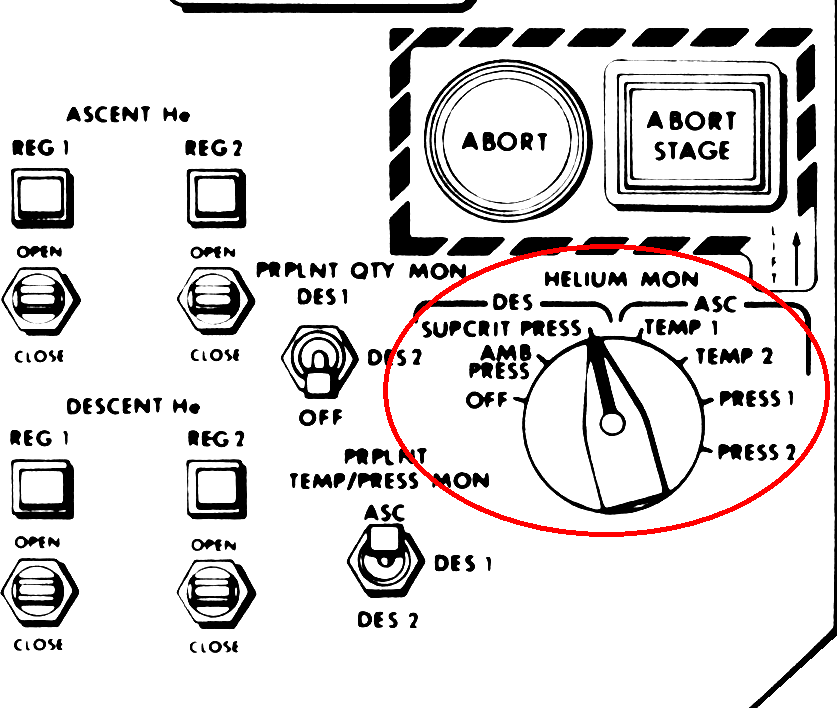
Pressure display selection dial in the LM control console. Original scan via heroicrelics.org.
050:44:31 Haise: Houston, 13. How do you read?
050:44:34 Kerwin: 13, Houston. You're coming through. We still have some background noise. Do you want to read back step 7? [Pause.]
050:44:53 Haise: Hello, Houston; 13.
050:44:55 Kerwin: 13, Houston. Go ahead.
050:45:00 Haise: Okay, Joe. The last thing I got was Helium Monitor to Supercrit Pressure. [Pause.]
050:45:07 Kerwin: Okay. The last part of step 7 is, 'Report Supercrit Pressure to MCC,' and read back step 7. [Long pause.]
050:45:30 Haise: Okay. Step 7. Circuit breaker panel 11, AC Bus B, Helium PQGS Display, Closed. Main - Circuit breaker panel 11, AC Bus B, Numeric Lighting, Closed. CD panel 11, AC Bus - Is that AC Bus B? Bus Tie Inverter 1, Closed?
050:45:51 Kerwin: That's affirmative.
050:45:53 Haise: And CB - CB EPS Inverter 1, panel 11, Closed. CB panel 16, Instrument Signal Sensor, Closed. Inverter 1, Select. Helium Monitor to Supercrit Pressure. Report pressure to MSFN.
050:46:09 Kerwin: Okay. That's correct. Now step 8 is, 'On MCC request, perform step 9.' In other words, you wait for us to decide what to do and that's according to the gauge we've already given you. And step 9, I'll give you now, is 'Helium Monitor to Off, Inverter to Off.' Over. [Pause.]
050:46:45 Haise: Okay. Step 8 says, 'Set in an MCC hold.' Step 9 says, 'On MCC's words, Helium Monitor Off, Inverter Off.'
050:47:00 Kerwin: Roger. That's correct. Step 10 is, 'Configure circuit breaker panels per Activation 3 and 4.' [Long pause.]
050:47:24 Haise: Okay. Configure - step 10, 'Configure circuit breakers per Activation pages 3 and 4.'
050:47:31 Kerwin: Roger. That's correct. Step 11 is, 'Deactivate the utility lights if you activated them,' and step 12 which is the last one is, 'Transfer to CSM power, usual observations, and report time to MCC.' [Long pause.]
050:48:20 Haise: Okay. Step 11, 'Deactivate utility lights.' 12, 'Transfer to CSM power and note the usual observations and report the GET.'
050:48:31 Kerwin: Okay. That's it. And, of course, Houston will be requesting you to go to step 9 if the pressure is less than 770. If the pressure is between 770 and 800, we will be asking you to do the following, if you're ready to copy. [Pause.]
050:48:59 Haise: Stand by. I've got to find some more blank paper.
050:49:01 Kerwin: Yes. This is going to be page TLC-3, but it's very short. [Long pause.]
050:49:25 Haise: Okay. Go ahead with TLC-3.
050:49:31 Kerwin: Okay. Stand by 10 seconds, Fred. [Long pause.]
050:50:20 Kerwin: Fred, Houston.
050:50:25 Haise: All right. Go ahead.
050:50:26 Kerwin: Roger. We'll hold off on that. It was a short three-step procedure which said, 'Repeat activation pages 1, 1A, and 2,' but there was another step in it that nobody understands. So, essentially what we'd recommend in that case would be that you would repeat the procedure that we just passed up for reading the Supercrit pressure. If we need to, we'll clarify it later on. And that's all we've got.
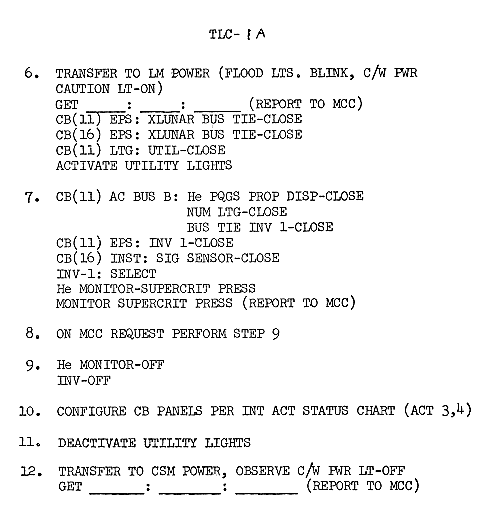
The SHe procedure checklist, from Flight Director's Log
This is Apollo Control Houston at 50 hours, 51 minutes now into the flight. We experienced some communications difficulties during that extended conversation. However, that was Joe Kerwin adding to the LM activation procedures for the 55-hour time in the Flight Plan giving steps required to get readings of the supercritical helium pressure in the LM after Jim Lovell and Fred Haise go inside Aquarius. Fred Haise copied that report for Apollo 13. We now show on our displays, Apollo 13 at 168,262 nautical miles [311,621 km] out from Earth and slowing down; traveling at a velocity now of 3,463 feet per second [1,056 m/s]. Continuing to monitor at 50 hours, 52 minutes; this is Apollo Control, Houston.
050:57:38 Lovell: Houston, 13.
050:57:44 Kerwin: 13, Houston. Go ahead.
050:57:49 Lovell: Okay. One thing, Joe; I just want to double check again. All the stuff that normally was going to start at 57 hours, which the first item was pressurize CSM to 5.7 psia, we're going to move that up to 54 now, so we have our LM entry which was nominally at 58 at 55. Is that correct?
050:58:10 Kerwin: That's correct, Jim.
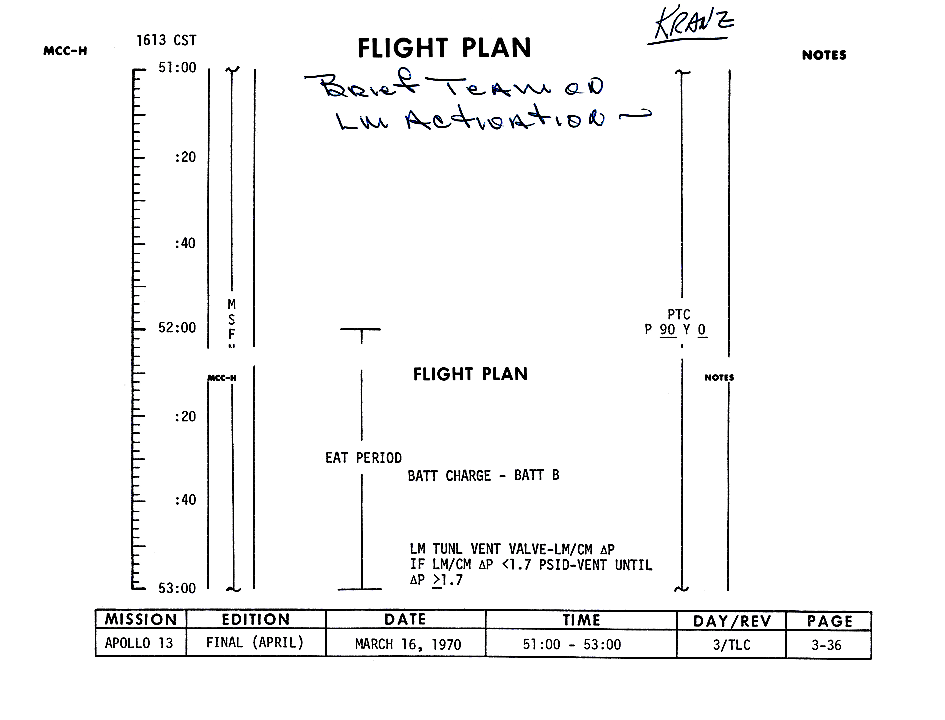
Changed flight plan for 51:00 to 53:00 GET with Gene Kranz' handwritten notes.
This is Apollo Control, Houston, at 51 hours, 3 minutes now into the flight. Apollo 13 presently shows an altitude of 168,651 nautical miles [312,342 km] relative to Earth, and traveling at a velocity of 3,455 feet per second [1,053 m/s]. Among those presently at the capsule communicator's console here in Mission Control is Command Module Pilot, Ken Mattingly. We're at 51 hours, 4 minutes into the flight and this is Apollo Control, Houston.
051:07:02 Kerwin: Apollo 13, Houston.
051:07:07 Lovell: Go ahead, Houston.
051:07:08 Kerwin: Roger, 13. Because of the O
2 tank 2 quantity sensor drop out, EECOM wants to keep a little closer track of the cryo quantities, and he's going to be asking you to stir all the cryo tanks at slightly more frequent intervals than had been planned, and the first time is now, and we will be calling you probably every 5 or 6 hours, except during sleep period and high activity periods. We'd like you to do it now. Over.
051:07:44 Lovell: Okay. We'll start it [garble] now.
051:07:46 Kerwin: Thank you. [Long pause.]
051:07:59 Kerwin: And, 13, Houston. For your information, a normal 1-minute or so stir will be fine.
This is Apollo Control, Houston; at 51 hours, 17 minutes into the flight. We presently show Apollo 13 at a distance of 169,111 nautical miles [313,194 km] out and travelling at a speed of 3,445 feet per second [1,050 m/s]. In the Mission Control Center we are having a change in capsule communicators. Vance Brand has reported in, taking the place of Joe Kerwin. We are at 51 hours, 18 minutes now; this is Apollo Control, Houston.
This is Apollo Control, Houston; at 51 hours, 29 minutes now in the flight. Apollo 13 now 169,526 nautical miles [313,962 km] in altitude and traveling at a velocity of 3,436 feet per second [1,047 m/s]. We've had no communication with the crew of Apollo 13 for about the last 30 minutes. It's very possible that they have also stepped ahead the eat period in their Flight Plan. We'll stand by however and continue to monitor and at 51 hours, 30 minutes into the flight; this is Apollo Control, Houston.
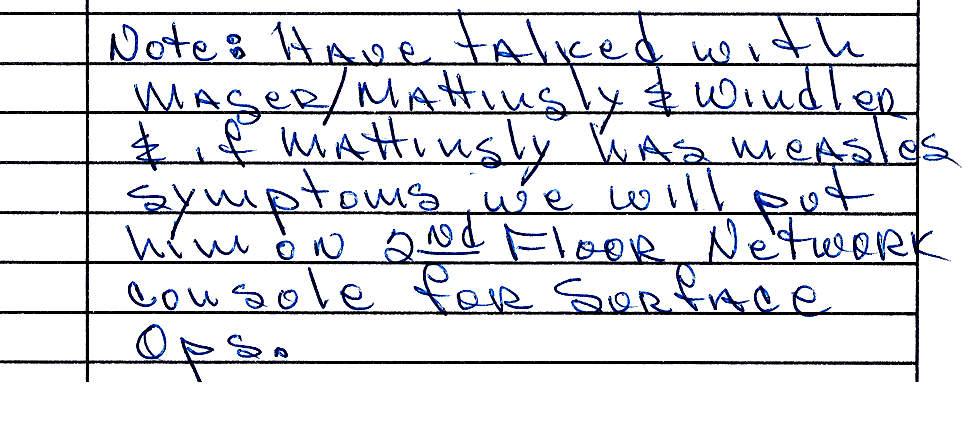
Gene Kranz' notes from around this time, concerning Ken Mattingly.
This is Apollo Control, Houston; at 52 hours, 7 minutes now into the flight of Apollo 13. Our digital display presently shows the Apollo 13 spacecraft at an altitude of 170,752 nautical miles [316,233 km], continuing to slow down now at a speed of 3,410 feet per second [1,039 m/s]. A relatively quiet period here on the second shift that the White Flight Control Team has pulled at this point in time. Most of the flight controllers talking things over with their respective backrooms. We have not had contact with the crew for almost an hour. We'll stand by and continue to monitor at 52 hours, 7 minutes into the flight. This is Apollo Control, Houston.
052:07:42 Brand: Apollo 13, Houston.
052:07:48 Lovell: Go ahead, Houston.
052:07:50 Brand: Jim, just an advisory; expect a Caution and Warning on H
2 tank 1 pretty quick. No problems; just warning you about it.
052:08:04 Lovell: Okay. A zero pressure light on H
2 tank 1 coming on shortly, huh?
052:08:11 Lovell: Okay. Well, you're pretty close. It just came on. [Pause.]
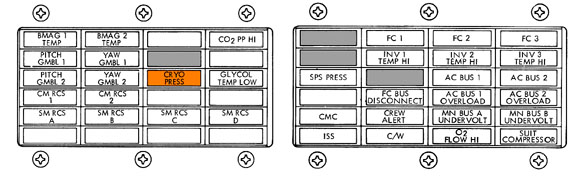
Cryo Press caution light illuminated, as it would have appeared to the crew.
052:08:20 Brand: Any other predictions you'd like?
052:08:26 Lovell: Well, there's - I guess there's all sorts. Could you go to the horse races with me?
052:08:32 Brand: I'm sorry; you were garbled. Say again?
052:08:37 Lovell: I said I'd like to invite you to the horse races with me.
052:08:41 Brand: Right. We'll - We'll send EECOM.
That was Vance Brand with a caution and warning light advisory timed almost to the second. Jim Lovell responded from the spacecraft. We're at 52 hours and 9 minutes into the flight and the show of Apollo 13 at 170,831 nautical miles [316,379 km] above the Earth, travelling at a speed of 3,408 feet per second [1,039 m/s]. Gene Kranz just spoke to the EECOM and said that's pretty lucky, then he said, 'Oh, correction, that's pretty skilful.' We are at 52 hours, 10 minutes into the flight and this is Apollo Control, Houston.
052:16:55 Haise: Well, it's time for a little grits again here, Vance.
052:17:01 Brand: Understand. Some grits, huh? Chow. Bon appetite.
Apollo Control, Houston. That was Fred Haise, a native of Mississippi, saying it's time for some grits in here now. Obviously his conversion of, for describing it's mealtime. We're at 52 hours, 18 minutes into the flight and this is Apollo Control, Houston.
This is Apollo Control, Houston at 52 hours, 23 minutes now into the mission. Apollo 13 is presently 171,246 nautical miles [317,148 km] away from Earth. Its present velocity reads 3,399 feet per second [1,036 m/s]. Continuing to monitor; this is Apollo Control, Houston.
This is Apollo Control, Houston at 52 hours, 36 minutes into the flight of Apollo 13. The Apollo 13 spacecraft now shows a distance of 171,726 nautical miles [318,036 km] away from Earth traveling at a speed of 3,389 feet per second [1,033 m/s]. We've just received a further update from the Flight Dynamics Officer with regard to predicted time and coordinates for the S-IVB impact. We now read a time of impact of 77 hours, 56 minutes, 45 seconds with coordinates now displayed here in Mission Control of 2 degrees, 33 minutes south; 18 degrees, 18 minutes west. We're at 52 hours, 37 minutes into the flight and this is Apollo Control, Houston.
052:45:20 Brand: Apollo 13, Houston.
052:45:25 Lovell: Go ahead, Houston.
052:45:27 Brand: Roger. Just expect that same Caution and Warning to come on again. And you want us to keep warning you of that thing? [Pause.]
052:45:43 Lovell: Go ahead, Houston.
052:45:47 Brand: Roger, Jim. Just expect a Caution and Warning to come on the same as it did about an hour ago. [Pause.]
052:46:04 Lovell: Go ahead, Houston. We've lost [garble].
052:46:08 Brand: Roger. How are you reading me now, Jim? [Long pause.]
052:46:33 Lovell: Houston, Apollo 13.
052:46:36 Brand: 13, Houston. How do you read now?
052:46:41 Lovell: Okay. Read you good now. Seems like we've had a little trouble with the comm today.
052:46:46 Brand: Yes. I guess it's partly because you are further out. We just wanted to tell you that you were going to get that Caution Warning that you just got.
052:46:58 Lovell: Right. We just got.
052:47:00 Brand: And I won't bother you with those calls anymore, unless you especially want them.
052:47:10 Lovell: That's okay, Vance. You don't have to call us about that, unless it's something serious.
052:47:14 Brand: Okay. [Long pause.]
052:47:32 Haise: We just ate a can of ham salad and that was an experience.
052:47:40 Brand: Roger. Copy. [Pause.]
052:47:49 Haise: It's really kind of like eating on the sly. Chasing it around. [Pause.]
052:48:02 Brand: Right. Copy. [Long pause.]
052:48:18 Haise: But good.
This is Apollo Control, Houston at 52 hours, 48 minutes into the flight. Spacecraft Apollo 13 is now at an altitude of 172,125 nautical miles [318,775 km] and going at a speed of 3,381 feet per second [1,031 m/s]. That last conversation exchange we heard from both Jim Lovell and later describing ham salad sandwich was Fred Haise. We're at 52 hours, 49 minutes into the flight and continuing to monitor; this is Apollo Control, Houston.
This is Apollo Control, Houston at 53 hours, 8 minutes into the mission. We now show Apollo 13 at a distance of 172,771 nautical miles [319,972 km] and traveling at a rate of speed of 3,367 feet per second [1,026 m/s]. This is Apollo Control, Houston.
053:19:28 Lovell: [Garbled]
053:19:31 Lovell: Houston, Apollo 13.
053:19:40 Brand: 13, Houston. Go ahead.
053:19:45 Lovell: Right, we're not doing anything right now, Vance, we're just getting curious, we could start the LM entry procedures, and get everything squared away, and then when the TV comes up at 55 hours, we can just use it for the TV, and we wouldn't be worrying about checking out the SHe tank pressures and everything like that.
053:20:07 Brand: Okay, let us mull that one a minute here, and I'll get right back with you.
This is Apollo Control, Houston at 53 hours, 21 minutes into the flight. Apollo 13 now at a distance of 173,207 nautical miles [320,779 km], and proceeding at a speed of 3,358 feet per second [1,024 m/s]. That last report came to us from the spacecraft Commander Jim Lovell. There is a discussion here in the Control Center now as to what our response may be. We're at 53 hours, 22 minutes; and continuing to monitor. This is Apollo Control, Houston.
053:23:35 Lovell: Also, Houston, Apollo 13. We'd like to move up the waste water dump and maybe the O
2 fuel cell purge a little bit early, if we could. [Pause.]
053:23:51 Brand: Okay, stand by.
053:26:30 Brand: Apollo 13, Houston.
053:26:35 Lovell: Go ahead, Houston.
053:26:37 Brand: Jim, you're clear to go on into the LM, and just advise though that the TV time is still fixed at 55 hours, and - so we'll be standing by to support your entry and we'll get back with you on a minute - in a minute on the O
2 fuel cell purge and the waste water dump.
053:26:59 Lovell: Okay. Sounds good.
053:27:02 Brand: And also request your LM/CM Delta-P which was on the Flight Plan for 53 hours. What did you vent it down to? Over. [Pause.]
053:27:16 Lovell: We have 1.7 now. We vented it down to that figure.
053:27:20 Brand: Okay, you vented down to 1.7, and what did it start at?
053:27:28 Lovell: It was about 1.1, Vance.
053:27:31 Brand: Roger, copy.
This is Apollo Control, Houston; 53 hours, 28 minutes. There you've heard the response from CapCom Vance Brand clearing the Apollo 13 commander and Lunar Module Pilot for going into the LM about an hour earlier than had previously been planned. However, the television transmission time will remain unchanged at 55 hours Ground Elapsed Time. We presently show Apollo 13 at an altitude of 173,422 nautical miles [321,177 km] and at a velocity of 3,354 feet per second [1,022 m/s]. This is Apollo Control, Houston.
053:34:32 Haise: Houston, 13.
053:34:35 Brand: Go ahead, 13.
053:34:40 Haise: What do you read for suit pressure down there? [Pause.]
053:34:53 Brand: We're reading 4.3, Fred.
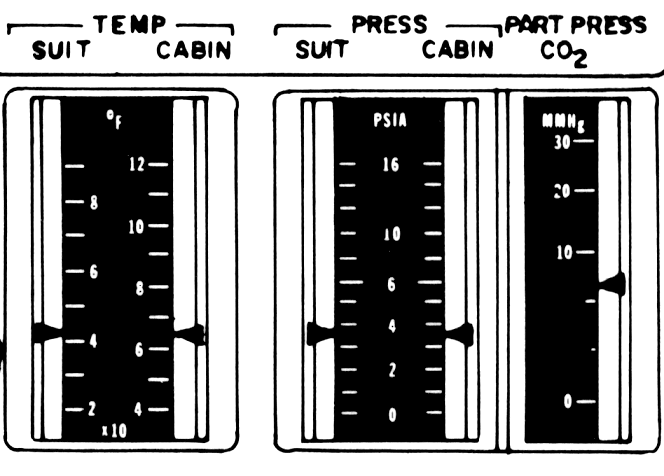
Onboard ECS tapemeters displaying pressure and temperature and CO2 levels. Original scan via heroicrelics.org
This is Apollo Control, Houston. So we have Jim Lovell and Fred Haise cleared to go inside Aquarius a bit earlier and they're proceeding in that direction now. Although Jim Lovell is presently the only astronaut to have taken a second trip atop the Saturn V and is the first of his group to make a second journey to the Moon, this evening will mark his first step inside the Lunar Module inflight. The Apollo 8 crew circled the Moon with the Command and Service Modules only. We'll standby and continue to monitor at 53 hours, 36 minutes into the flight.
053:38:58 Lovell: Houston, 13.
053:39:03 Brand: Go ahead, Apollo 13.
053:39:07 Lovell: We'd like another confirmation, when we closed the tunnel vent valve back to LM/CM Delta-P, we were reading about 1.7 - 1.75, and it slowly went up now to about - oh, I'd say a little less than 2.2. Seems to be holding there - Is there a lag in the gauging system?
053:39:33 Brand: Okay. We'll - we'll ask that question. Stand by.
053:40:58 Brand: Apollo 13, Houston.
053:42:07 Brand: Apollo 13, Houston. [Long pause.]
053:42:24 Brand: Apollo 13, Houston.
053:42:30 Lovell: Go ahead, Houston.
053:42:32 Brand: Okay, to answer your question, Jim, that increase in pressure is normal, because it was just tracking an increase in cabin pressure.
053:42:46 Lovell: Okay. Okay.
053:42:57 Lovell: We're not thinking today. [Long pause.]
053:43:20 Brand: And, 13, from Houston, it's okay with us if you want to move the O
2 fuel cell purge and the water dump up to this time. Over.
053:43:33 Lovell: Okay. We'll work it in shortly. Thank you.
This is Apollo Control, Houston at 53 hours, 44 minutes into the mission. Apollo 13 at the present time 173,934 nautical miles [322,126 km] out from Earth and now going at a speed of 3,343 feet per second [1,019 m/s]. We're at 53 hours, 44 minutes and this is Apollo Control, Houston.
053:45:11 Brand: Apollo 13, Houston.
053:45:16 Lovell: Go ahead.
053:45:17 Brand: Jim, recommend you stay in the PTC until we stop it for the TV at 55 hours, in case you were thinking of...
053:45:24 Lovell: Go ahead, Houston.
053:45:26 Brand: Roger. Recommend you continue PTC until 55 hours. Over. [Long pause.]
Apollo Control, Houston. EECOM confirmed to Flight Director Gene Kranz the fuel cells are being purged and water dump being accomplished at this time.
053:46:05 Lovell: You were calling, Houston? [Pause.]
053:46:12 Brand: That's affirmed, Jim. How do you read now?
053:46:17 Lovell: Okay. We read you loud and clear.
053:46:19 Brand: Okay. The only comment that we just made was that, in case you were thinking of stopping PTC, there's no need to stop it until 55 GET when TV starts.
053:46:34 Lovell: Right. We'll stop it when we're setting up our TV.
Apollo Control, Houston. 53 hours, 48 minutes. EECOM confirms to Flight Director Gene Kranz that the cabin pressures are being equalized now. We presently show Apollo 13 at an altitude of 174,070 nautical miles [322,378 km] and traveling at a speed of 3,340 feet per second [1,018 m/s]. We're at 53 hours, 48 minutes; this is Apollo Control, Houston.
Apollo Control, Houston. 53 hours, 51 minutes. EECOM reports the cabin pressures have leveled off now, reading 4.7 - 4.8. We now show Apollo 13 at 174,160 nautical miles [322,544 km] away and going at a speed of 3,338 feet per second [1,017 m/s]. This is Apollo Control, Houston.
053:54:34 Swigert: Okay, Houston, the waste water dump and O
2 fuel cell purge are complete.
053:54:41 Young: Houston. Roger.
This is Apollo Control, Houston, at 53 hours 55 minutes. That was Back-up Commander for Apollo 13, John Young, returning that call from the spacecraft. Capsule communicator Vance Brand has left his console for a brief period of time to attend a meeting on the LM activation procedures and the monitoring of the super critical helium tank readings. We're at 53 hours 55 minutes and now show Apollo 13 at 174,309 nautical miles and traveling at a rate of speed of 3,500 correction 3,335 feet per second. This is Apollo Control, Houston.
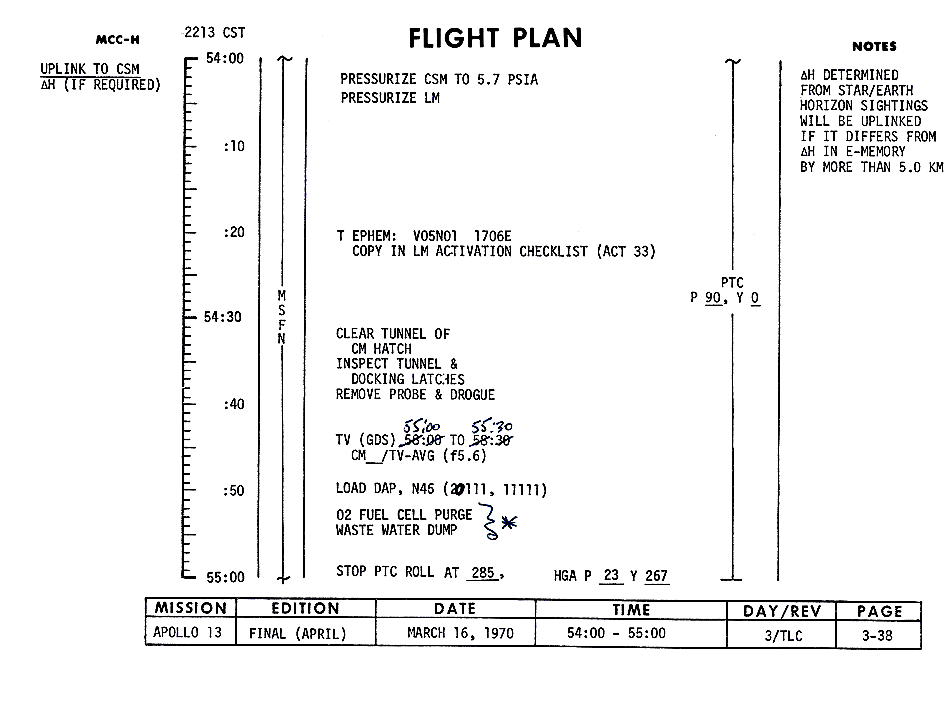
Edited Flight Plan for 54:00 to 55:00 GET. With Gene Kranz' handwritten notes.
054:05:54 Swigert: Okay, Houston, the LM/CM Delta-P is constant. We're going to go ahead with hatch removal.
054:06:04 Young: Houston. Roger. [Pause.]
Apollo Control, Houston. That was Fred Haise telling Houston that they're ready to proceed with hatch opening.
054:06:16 Swigert: Is that you, Jack?
054:06:20 Young: No, this is Jack's replacement.
Apollo 13 apparently mystified for the moment about John Young's voice. We show 13 at an altitude of 174,664 nautical miles [323,478 km] with a velocity of 3,328 feet per second [1,014 m/s]. We're now at 54 hours, 7 minutes into the flight and this is Apollo Control, Houston.
054:24:15 Swigert: Okay, Houston; 13.
054:24:18 Young: Houston, go ahead.
054:24:25 Young: Go ahead, 13. [Long pause.]
054:24:46 Swigert: Houston, Apollo 13.
054:24:49 Young: This is Houston. Go ahead, 13. [Long pause.]
054:25:18 Swigert: Okay, Houston; Apollo 13.
054:25:22 Young: Roger. Go ahead, 13.
054:25:28 Swigert: Okay. The LMP has entered the LM.
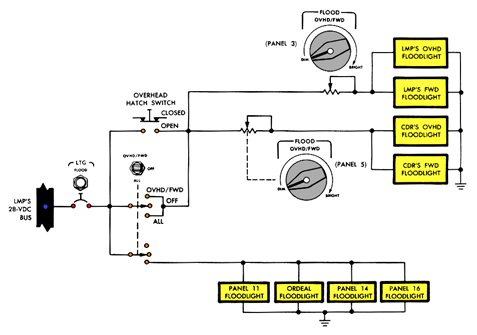
A diagram of the switch and the wiring that activates LM lightning automatically upon entry.
Apollo...
054:25:37 Swigert: Is that Big John?
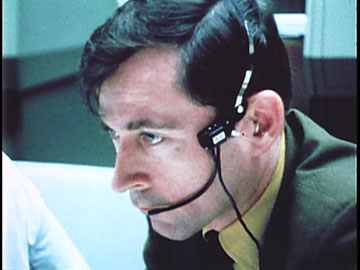
Backup Commander John Young at the CapCom position.
054:25:39 Young: It sure is. How're you doing?
054:25:44 Young: Yes, you're doing great, man.
054:25:49 Swigert: Thank you. I had a good CDR.
054:25:54 Young: You're doing it on your own now.
054:26:01 Haise: Yes, it feels like I'm back at home, again, John, down in here.
054:26:04 Swigert: I hope you did a good job, John.
054:26:06 Young: Roger. [Long pause.]
Apollo Control, Houston; 54 hours, 26 minutes into the flight. That was Jack Swigert reporting that Fred Haise is now inside the Lunar Module. And carrying on a brief discussion with his former spacecraft Commander - his backup Commander - for this mission, John Young. We now show Apollo 13 at an altitude of 175,307 nautical miles [324,669 km].
054:26:40 Swigert: Okay, Houston, we want to take the FM and bring up TV here for our own use. Then we'll go to Transmit 1 - at 55 hours. [Pause.]
054:26:58 Lousma: Roger, 13.
Apollo 13 now traveling at a speed of 3,314 feet per second [1,010 m/s]. We're at 54 hours, 27 minutes now into the flight, and this is Apollo Control, Houston.
This is Apollo Control, Houston at 54 hours, 42 minutes now into the flight of Apollo 13. Apollo 13 now shows an altitude of 175,826 nautical miles [325,630 km] and its speed reads 3,304 feet per second [1,007 m/s]. Network has been advised by Goldstone that network does now have the capability of receiving television at any time. We will stand by in the event we should receive an early television transmission. At this point we do not expect to receive such, but we will stand by at 54 hours, 43 minutes into the flight. This is Apollo Control, Houston.
054:46:28 Swigert: Okay, Houston, we've transferred to LM power; the time was 54 hours, 46 minutes, 15 seconds.
054:46:40 Lousma: Roger, Jack. Transfer to LM power. Thank you.
054:46:47 Haise: And the docking-tunnel index, Jack, was minus 2 degrees.
054:46:54 Lousma: Say again, Fred, you're coming in with a lot of background noise.
054:47:00 Haise: Okay. The docking-tunnel index mark was minus 2 degrees.
054:47:05 Lousma: Roger. Minus 2 degrees.
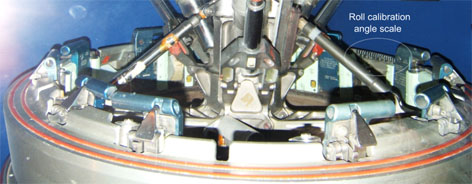
The CSM's docking interface with the docking index highlighted.
054:49:17 Haise: Okay. Jack, how do you read? [Pause.]
054:49:29 Lousma: Fred, Houston is reading you loud and clear.
054:49:34 Haise: Okay. I've got up through step 7 now, and I'm not getting much of a light in the helium indicator here. Why don't I review for you how we've proceeded, and you look at the procedure you gave me, and see if we've missed anything.
054:49:53 Lousma: Roger. Go ahead.
054:49:57 Haise: Okay. We transferred to LM power and that looked okay. I'm staring at a Caution and Warning Power light, and all the red flags; and we got both X Lunar Bus Tie breakers, In. The Utility Lighting breaker is In; then AC Bus B Helium PQS Display; the AC Bus B Numeric Lighting, and AC Bus B Inverter 1 is - Bus Tie is Closed. Then I closed the Inverter 1 breaker, and I've selected, on panel 16, and the Signal Consensor [sic] breaker is in; I've selected Inverter 1 and put the Helium Monitor switch to Supercrit and I have no lights. [Pause.]
054:51:06 Lousma: Okay, Fred, let us take a look at it.
054:51:07 Haise: I was wondering, do we need an A - do we need, possibly, in the - one of the Anun/Dock/Component breakers in?
054:51:18 Lousma: Stand by one. [Long pause.]
054:51:33 Haise: Okay, Jack. Hold the phone. I forgot the rheostat was cranked all the way down on the Anun/Num and it's showing 720, which looks like a pretty good - pretty good number.
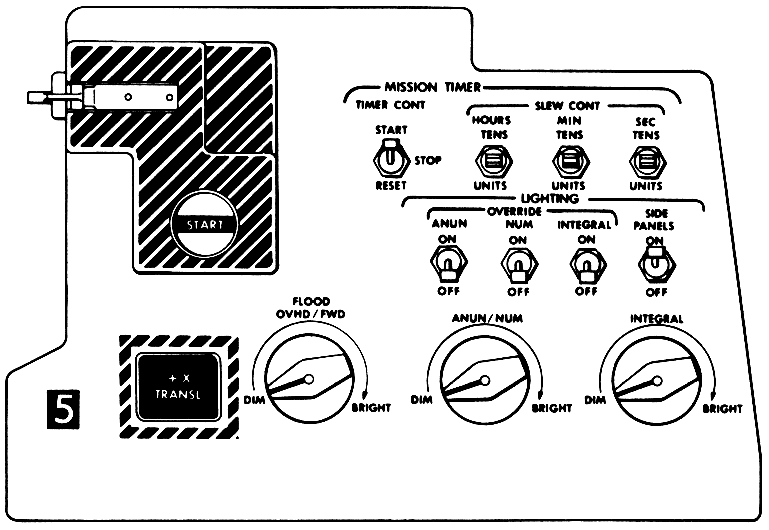
Panel 5 in the LM. Original scan via heroicrelics.org
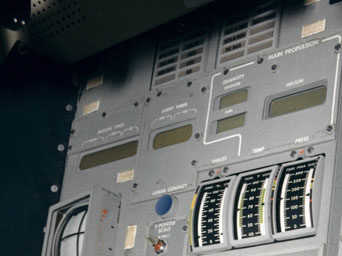
The digital LM gauges. From Apollo 16 LM Orion via ALSJ.
054:51:47 Lousma: Roger. We copy 720. Thank you, Fred...
054:51:49 Haise: Flashed to 7 - Okay, and it just flickered down to 710. It's kind of flickering between 710 and 720.
054:52:00 Lousma: Roger. 710 to 720. [Pause.]
054:52:16 Lousma: Okay, Fred. Those are good numbers, and we're not going to have to crank up the TM. That's the number we were looking for.
054:52:26 Haise: Very good. Okay. Do you want me to back out of this in reverse at least as far as getting this part of it powered down?
054:52:36 Lousma: Stand by one. [Long pause.]
You heard that report from Fred Haise.
054:52:56 Lousma: Fred, this is Houston. Go ahead and back out of this little test and proceed.
Our supercritical helium pressure reading was 720 pounds per square inch. A very desirable number. We're at 54 hours, 53 minutes now into the flight. Apollo 13 at 176,171 nautical miles [326,269 km] away from Earth. We're standing by now for receipt of television.
Apollo Control, Houston; 54 hours, 55 minutes. We repeat that earlier report from LM pilot Fred Haise. He read his supercritical helium pressure at 720 pounds per square inch. Well under the 770 pounds per square inch mark earlier identified as a point for further scrutinization.
We now show 13 traveling at 3,296 feet per second [1,005 m/s] and at an altitude of 176,240 nautical miles [326,396 km].
Apollo Control, Houston at 54 hours, 57 minutes. Jack Lousma is now filling the position of capsule communicator in the Mission Control Center. That was Jack who received that last report from Lunar Module Pilot Fred Haise. Standing by; this is Apollo Control, Houston.
054:59:01 Swigert: Okay. We're back on CSM power. The time was 54 hours, 58 minutes, 50 seconds.
054:59:10 Lousma: Roger, Jack. 54:58:50. Thank you. [Pause.]
054:59:26 Swigert: Okay, Houston, we'll try to pick you up on the High Gain.
054:59:32 Lousma: Roger. [Long pause.]
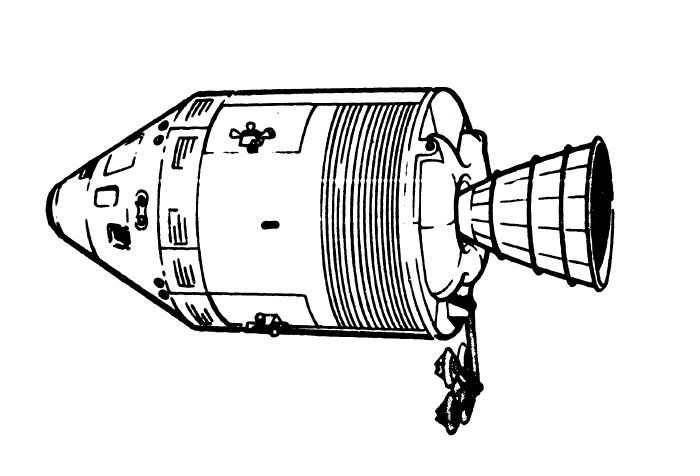
CSM with the High Gain Antenna deployed
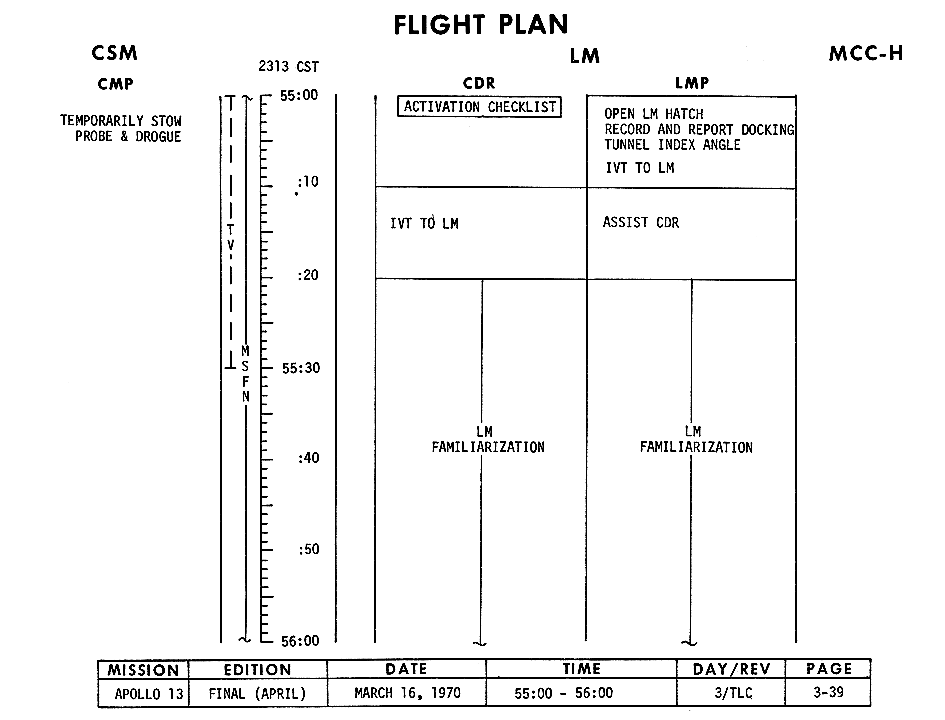
Edited Flight Plan for 55:00 to 56:00 GET.
Apollo Control, Houston. Standing by now for receipt of television transmission.
055:00:08 Lousma: And, 13, we're ready on the TV when you are. [Pause.]
055:00:19 Lovell: This is 13. Say again, Houston.
055:00:23 Lousma: 13, we're ready on the TV when you are. Any time.
055:00:28 Lovell: Okay, sounds good. With you in a minute, we're just cranking up High Gain now. [Long pause.]
055:01:20 Lovell: Okay, Houston. How do you read us in the High Gain?
055:01:23 Lousma: We're hearing you 5 square, Jim, how me?
055:01:28 Lovell: Okay. You're coming through okay. [Pause.]
055:01:40 Lousma: As you were on that, Jim. We don't have you on High Gain yet. We're still looking at you. [Long pause.]
055:02:27 Lousma: 13, Houston. In this attitude, we'd suggest pitch 5, yaw 237 on the High Gain. Over.
055:02:39 Lovell: Pitch 5, yaw 237. Roger.
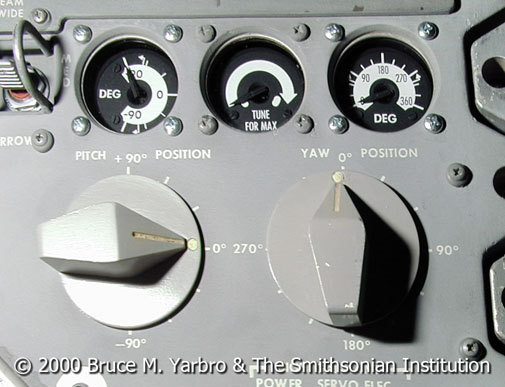
High Gain Antenna controls photographed inside the Command Module Odyssey
Apollo Control, Houston; 55 hours, 05 minutes. Continuing to stand by for television transmission.
055:05:12 Swigert: Okay, Jack. Can you - can you read the High Gain now? [Pause.]
055:05:24 Lousma: Affirmative, Jack. We've got you on a High Gain and it appears to us that we're in Wide beam - Wide beam width.
055:05:32 Swigert: Yes. We can't get it to come down to Narrow. We tried to switch to Auto Track or Reacq, and it - yaw drives around from 270 to 0. And pitch goes from about 6 degrees around to 90. I'm trying - we're fitting it manual now at the angles that you gave us, and I'll try and get you in Medium and Narrow beam width picking it up manually here.
055:06:06 Lousma: Roger, Jack. Meanwhile, we'll look at the situation you describe there.
055:06:13 Swigert: Okay. And it does it on both sets of servo electronic power. [Long pause.]
Apollo Control, Houston; 55 hours, 07 minutes. We now show Apollo 13 at 176,598 nautical miles [327,059 km].
055:07:15 Swigert: Jack, what it looks like is that, when we hit 239 degrees at this attitude, it hit some sort of scan limit or something and drops off. [Pause.]
055:07:33 Lousma: Roger, Jack; thank you.
055:07:37 Swigert: Okay, I'm trying you in Wide or Medium beam width now. [Pause.]
055:07:54 Swigert: Can you pick up the TV in this condition here at all? [Pause.]
055:08:07 Lousma: Negative, Jack. We'll have to have the Narrow beam width.
055:08:14 Swigert: Okay. Can you give us, maybe, a slight maneuver? [Long pause.]
055:09:09 Lousma: Jack, we'd like you to check two High Gain circuit breakers down in panel 25. Check your High Gain group 2 and your High Gain in the flight bus. Over.
055:09:19 Swigert: Okay. Okay, Jack, they're both In.
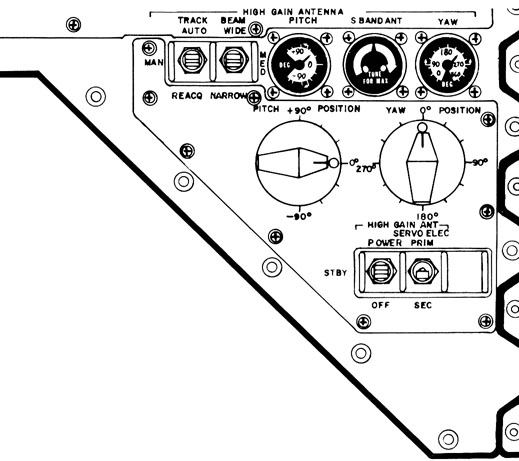
High Gain Antenna controls diagram. Courtesies of heroicrelics.org.
055:10:43 Lousma: 13, we've got an attitude suggestion for you. We suggest that you go to roll 285 and try pitch 90 and yaw 0. Over.
055:14:00 Lovell: Okay, Houston; Apollo 13. I think we've got High Gain locked up now. Do you confirm?
055:14:07 Lousma: We confirm that, Jim, we've got you locked up on the High Gain and narrow beam.
055:14:13 Lovell: Okay, sounds good. We'll get the TV started right away.
055:14:16 Lousma: Roger. [Long pause.]
That was spacecraft Commander Jim Lovell confirming that they had the High Gain narrow beam locked up.
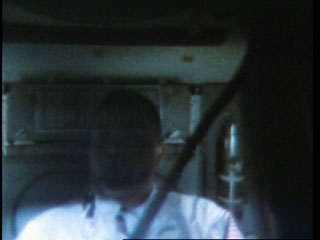
A ghostly Fred Haise is the first thing to appear on TV.
055:14:36 Lousma: 13, Houston. We'd like to disable Quads C and D; use Alpha and Bravo. Over. [Pause.]
We're now receiving a transmission, television transmission.
055:14:44 Swigert: Okay... [Long pause.]
055:14:45 Lovell: ...Disable quads C and D. Roger.
055:14:56 Lousma: Okay, 13. We've got Freddo on TV.
055:15:04 Lovell: Roger, Houston. What we plan to do for you today is start out in the space shipper [sic] Odyssey, and take you on through from Odyssey in through the tunnel into Aquarius. And show you a little bit of the landing vehicle, and your TV operator is now resting on the center couch, looking at Fred Haise, whose head is now just about at the beginning of the tunnel, and his back is against the Lower Equipment Bay optical area. And Fred will now transport himself into the tunnel, and into the spaceship Aquarius.
055:15:48 Haise: You know one thing I noted, Jack, when I first came across here, that starting upright in the Command Module and heading down in Aquarius, there's a little bit of an orientation change that, even though I'd been through it once in the water tank, it still pretty unusual. I find myself, now, standing with my head on the floor when I get down inside the LM. [Pause.]
055:16:25 Lousma: That's a great picture, Jim. You got the light just right. [Pause.]
055:16:40 Haise: And one of the nice things, Jack, particularly for a novice like myself, is the - the ease of moving around in here. It's, of course, as you know from working in the Command Module Simulator, it's really quite a boon to have zero gravity as an aid. Because you get - pretty confining, really, at one g, to move around very much in there, and it's quite easy in this environment. The LM, as you can see, it looked pretty clean, I found a couple of loose washers about it and the - a little plastic cap off the sequence camera had come loose and I found it lodged over by the ED panel. Okay. Right under Jim, now, he's actually standing on a - what looks to be a can here. And, for the sake of all the people back there, housed inside this can is the - the LM ascent engine where, hopefully, you can see my hand resting on top of right now - the engine that we use to get off of the Moon. Immediately adjacent to the engine cover here, I have my hand on a white box now, which has been shown before. This happens to be Jim's PLSS, or the backpack which'll supply oxygen and water for cooling while on the lunar surface. This device we hope to make use of for - a planned 4 hours and possibly up to as much as 5 hours. Right - right behind the PLSS, a couple of little square packages I now have my hand on here, one here and one right below, are our OPSs, which are, in essence, the emergency oxygen supplies, which are good for some 40 to 45 minutes. These are - when we get ready to mount up and head outside, will be placed up on top of the PLSS. [Long pause.]
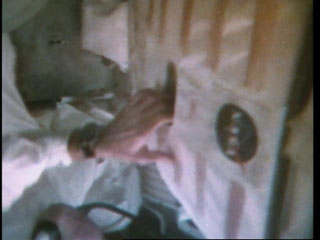
Fred uses the PLSS as a handhold.
055:19:24 Haise: The second backpack is mounted down on the LM floor, I hope, positioned right between the two of us. I have my hand on it at this time.
055:19:41 Lousma: Roger, Fred. We see it. The picture's coming through real good, and your description is good. We see Jim's got the camera oriented the way we like to look at it. So, keep talking. [Pause.]
055:20:05 Haise: Okay. I guess everybody has pretty much envisioned the space program as being all a lot of exotic electronics, and, certainly, a lot of it is. But I thought I'd bring out a couple of items here in conjunction with the PLSS. After the first EVA, you get a very accurate measurement of the amount of water that's left in the PLSSs. We're going to make use of this bag I'm showing now to collect the remaining water out of the PLSS and see just how much we really did have left, and hopefully, on future missions, to be able to extend safely the allowable time on these units even a little further. And, my other hand, I have the mechanism by which we determine just how much water we really have in this bag. And I guess this - an apt description for this device would be a fish scale. And you can see I'm weighing myself right now, and it says I weigh actually less than zero right now. Guess its calibration isn't too good.
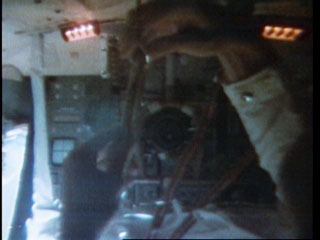
Fred demonstrates the PLSS water condensate scale.
055:21:22 Lousma: That'll be the day. [Pause.]
055:21:29 Haise: I think even you'd weigh zero here, Jack. [Pause.]
055:21:38 Lousma: Touché [Long pause.].
Apollo Control, Houston. We now show 13 at 175,000 nautical miles [324,100 km] in altitude.
055:22:14 Lovell: Houston, this is Jim. Since Fred's been in the Lunar Module, and since he's the Lunar Module Pilot, this is the first time that he's felt that he's been right-side up. [Pause.]
055:22:34 Lousma: Roger, Jim.
055:22:37 Lovell: I might tell you that we're looking at right now, that round bag that's just behind Fred holds our vacuum hose; and when we get back inside the LM, we'll hook the vacuum off our suits, and it's resting or it's attached to the hatch which will - we will open to go on to the lunar surface, and, of course, to come back in. The hatch which we have come to now is a round hatch, which is our docking hatch between the - between Odyssey and Aquarius.
055:23:11 Lousma: Roger, and we see Fred looking in the vacuum cleaner there now. [Pause.]
055:23:22 Haise: Okay, what I have out now, Jack, is LEVA, which has also been shown before. It's a head garment for wearing out on the surface, and I - I'm bringing Jim's out here to show a couple of mods [modifications]. One problem before is that the cast of characters down on the surface haven't been able to be distinguished apart very well. So, not only Jim's suit has some red stripes on it, but as you can see his LEVA also has a - a red stripe. [Long pause.]
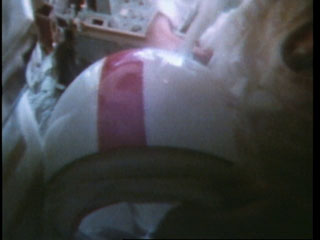
CDR's LEVA - lunar surface visor.
055:24:27 Haise: And now you can see one other mod here too, Jack, which I hadn't really seen myself before. I guess on 12, Pete and Al had commented about the - commented about having trouble with sunlight in the eyes, so on our LEVAs they put on a new center section which you can pull down and use sort of like a baseball cap.
055:24:56 Lovell: Okay, Jack. Who fixed up our LEVAs? [Long pause.]
055:25:12 Haise: How's the detail on this one, Jack?
055:25:15 Lousma: Say again, Fred.
055:25:19 Haise: Can you see any detail in this picture now, or am I blocking out too much of the sunlight?
055:25:26 Lousma: That's affirmative. We've got a good picture of the LEVA there, and it's coming through loud and clear.
055:25:35 Haise: Okay. [Long pause.]
055:25:54 Lovell: Okay, Jack, while Fred is putting away my helmet, you are looking over into Fred's station now. How's this picture, is it okay before - or do I have to adjust it?
055:26:06 Lousma: We have a hunch that the setting might be in Peak but we recommend Average on the ALC if you haven't got it there already.
055:26:16 Lovell: We're in Average, Jack.
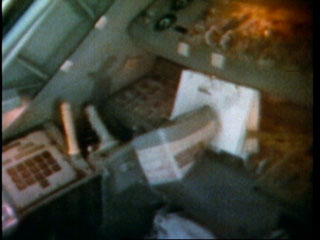
LMP's side of the LM cabin
055:26:18 Lousma: Okay. And we're getting a good picture of the LMP side with the DEDA over there. [Pause.]
055:26:29 Swigert: Hey, Jack, one question on the Command Module here. Do I - I have the DAP right now wide deadband. Do you want me to begin setting up narrow dead band and nulling the rates to start PTC again. [Pause.]
055:26:47 Lousma: Stand by, Jack. [Long pause.]
055:27:31 Haise: What I'm fishing out now, Jack, is another new piece of hardware that we are taking along this time as a result of some comments made on the Apollo 12 flight. [Pause.]
055:27:52 Lovell: What Fred is opening up - is a drink bag that we place inside of our neckring that will allow us to drink while we are on the lunar surface. They - Pete and Al - did not have that on Apollo 12 and they, consequently, got very thirsty. But we hope to alleviate that situation by having our own little bag of water which, with very little effort, we can have a sip or two while we are looking around and doing our geology work. [Pause.]
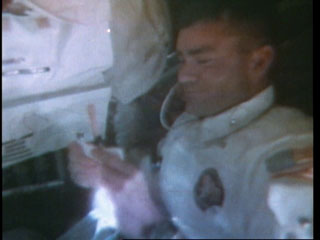
Fred Haise with the EVA in-suit water bag.
055:28:33 Haise: So if you hear any funny noises, it is just probably the drink bag. [Pause.]
055:28:50 Lovell: Fred, the bag's empty. [Long pause.]
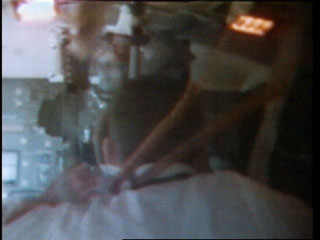
Fred Haise peers into the Alignment Optical Telescope.
055:29:16 Lovell: Fred is now looking through our optical device. It's an instrument in which to align our platform, and Fred is now looking into it just to see what kind of an outside picture he might be able to get. We might be able to use a TV camera to look through our optical instrument to the outside of the Command Module. A few minutes ago while we first came in, we did manage to look to the outside of the side hatch of the Command Module through our optical instrument. Stand by. We'll try to see what we can do here.
055:29:49 Lousma: Roger, Jim. Break, Jack, we'd like you to stay in the dead band you are now in, and we'll make a change when the TV is over. Another thing we would like you to do is check your pitch and yaw on your High Gain meter so we can compare it with what we're seeing down here. [Pause.]
055:30:11 Swigert: Okay, it's showing about - say 28 degrees and 267.
055:30:18 Lousma: 20 and 267.
055:30:21 Swigert: 28 - 28 and 267. [Long pause.]
055:30:45 Haise: Okay, Jack, Have you got that picture now?
055:30:49 Lousma: Fred, about one-quarter of our screen is lighted, and it's impossible to determine what you are looking at right now. Maybe you could give us a little verbal description.
055:31:02 Haise: Okay. It's looking through the AOT in position 4, right rear. And we're looking back toward the ... over the side hatch at the aft side of the service module. [Pause.]
055:31:28 Haise: Okay. Is - is it too dark a picture, Jack? You think the f-stop open may help?
055:31:34 Lousma: No, Fred, it's got to be centered up a little bit. That's primarily what you have to do.
055:31:43 Lovell: Jack, we can't center it up any more, because the side hatch is only one part of the AOT. The rest of that blackness you see is really space. [Long pause.]
055:32:11 Haise: Okay. We'll try another one, and it's a little better centered. In fact, the only other one we have that shows the whole picture. We're in the forward detent of the AOT now, position 2, and you should be seeing something familiar like a radar antenna. [Pause.]
055:32:41 Lousma: Okay, we see you moving the camera up to the AOT lens, and we got a real good picture now. [Long pause.]
055:33:03 Lovell: And... [Long pause.]
055:33:23 Haise: Okay, Jack, I'm looking out the right window now, and not too far off in the distance now, you can see the objective, and I'll zoom in on it here a little and see if it brings it in better. [Long pause.]
055:33:57 Haise: And it's actually beginning to look a little bigger now. You can see quite distinctly some of the features with the naked eye. And so far, I guess I have to even agree with Jim that it's still looking pretty gray with white spots. [Long pause.]
055:34:39 Lousma: Okay, Fred. We're getting a good picture of your destination there. [Long pause.]
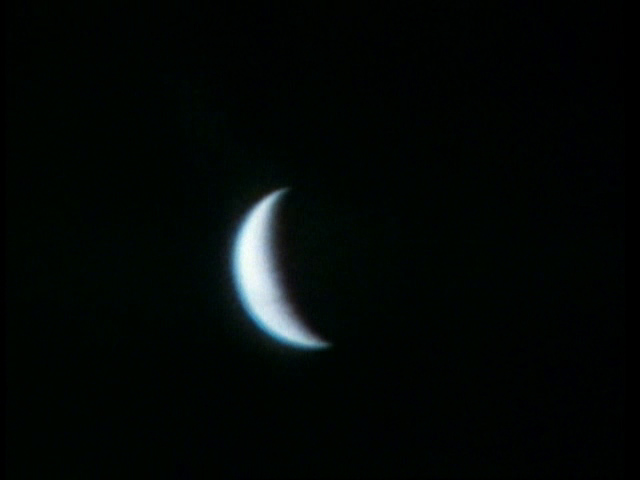
The Moon viewed through the AOT and the TV camera
055:35:04 Lovell: Jack, you've been looking at the - at Fred's workshop now, and you can see the abort guidance computer. And over there on the - tucked away in his armrest, is our activation checklist, which we'll be using very shortly. Up on the top of the window, we have our camera already mounted ready for photographing the descent. And now Fred's engaged in his favorite pastime, I found out on this flight so far. [Pause.]
055:35:47 Lousma: He's not in the food locker, is he?
055:35:52 Lovell: That's his second favorite pastime. He's rigging his hammock for sleep on the lunar surface now to find out - to see what it's going to be like.
055:36:03 Lousma: Roger. Sleeping and then eating. [Long pause.]
055:36:29 Haise: It's kind of difficult here, Jack, getting into a hammock in zero g. I'm not sure if I keep floating away from it or it keeps moving away from me. [Pause.]
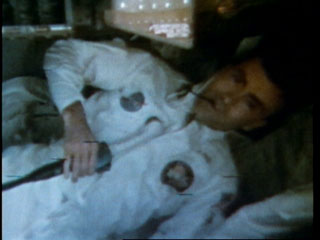
Fred poses from his hammock.
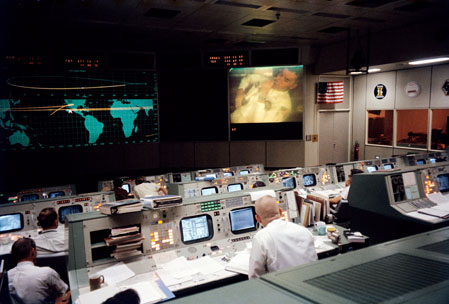
Photo S70-35139, from Mission Control.
055:36:50 Lovell: If you notice a few things floating around, we found just about one or two washers occasionally.
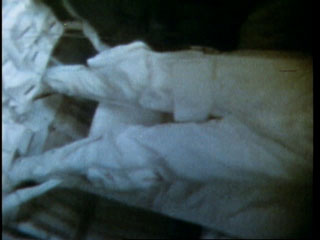
Fred's legs float above the hammock.
055:36:57 Haise: And for the benefit of those that may wonder where Jim sleeps. Be a little difficult to rig his hammock in here right now with the hatch open, but his runs laterally in this direction, fore-aft. So he has the upper berth and I get the lower berth. [Long pause.]
[A diagram showing the sleeping arrangements, as described by Fred, can be viewed here.]
055:37:34 Lovell: And now while Fred's taking his hammock down and restowing it, I might give you some idea of what sort of confusion of attitudes since there is no up or down, and I'm situated on top of the ascent engine just at the entrance to the tunnel. I'll reverse the camera 180 degrees and go from Fred, look through the tunnel again back at Odyssey, and we might pick up part of Jack. [Long pause.]
055:38:25 Lousma: There he is. We see him. [Long pause.]
That's Jim Lovell now pointing the camera at Jack Swigert in Odyssey. We're at 55 hours, 38 minutes into the flight of Apollo 13.
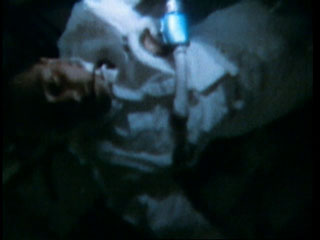
A "reluctant" TV star, Jack Swigert.
055:38:56 Lovell: Okay, Houston. For the benefit of the television viewers, we've just about completed our little inspection of Aquarius, and now we're proceeding through the hatchy-gap into the tunnel and going back toward the Odyssey. [Pause.]
055:39:22 Lousma: Okay, Jim. It's been a great show so far. [Long pause.]
This is Apollo Control, Houston; 55 hours, 39 minutes now into the flight. We presently show Odyssey and Aquarius at an altitude of 175,552 nautical miles [325,122 km]. Now traveling at a speed of 3,171 feet per second [967 m/s]. Although we copied no voice confirmation as to exactly when spacecraft commander Jim Lovell first went inside Aquarius, the Flight Plan called for a - for an ingress time of 54 hours, 30 minutes and we assumed that this occurred around that time.
055:40:20 Lovell: And finally, Jack's let me back into the Odyssey as we slide on through the tunnel here. [Long pause.]
055:41:14 Lovell: Houston, 13. Are you still on TV?
055:41:17 Lousma: Yes, we sure are. We've got a good picture of the skipper there.
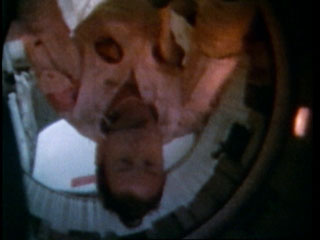
Jim Lovell seen in the tunnel between the CM and the LM.
055:41:22 Lovell: Okay. What we can show you now, a little added benefit, we've got the drogue on Fred's couch in the Command Module right now, we stowed it temporarily while we're checking out the - out Aquarius and underneath his couch, we've got the probes stowed. Quite a big cumbersome device, and we'll get a shot of it for you. [Long pause.]
055:42:13 Lovell: You're looking now at our probe, the place on the nose of Odyssey. It's a very heavy thing but I suppose in zero gravity it weighs nothing, and it's much easier to move around. As a matter of fact, both Fred and Jack commented, as many people in the past have, of how much bigger the spacecraft appears in actual flight when you have such ease in moving compared to our simulator which make training rather difficult. [Long pause.]
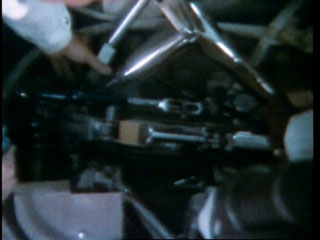
Jim Lovell demonstrates the docking probe.
055:42:58 Lousma: Okay. We're seeing a good picture of the probe there, Jim, and looks like the characters shaved before the show this time.
055:43:10 Lovell: Well, Fred said he had to keep up his TV image.
055:43:17 Haise: Yes. That may be my first and last time though, Jack.
055:43:21 Lovell: It took Fred one hour to shave. [Long pause.]
055:43:37 Lovell: We might give you a quick - a quick shot of our entertainment on board the spacecraft, which has been keeping us company for some time. [Long pause.]
055:43:57 (Music - Willow Weep For Me)
055:44:15 Lovell: This little tape recorder has been a big benefit - has been a big benefit to us in passing some of our time away on our transit to the Moon, and it's rather odd to see it floating like this in Odyssey while it's playing the theme from '2001'. And, of course, the tapes wouldn't be complete without 'Aquarius'. [Long pause.]
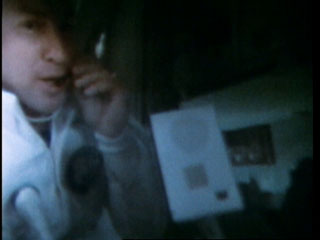
Jim Lovell with his floating cassette player.
055:45:08 Lousma: Okay, Jim. We're seeing the tape recorder now, and just - by the way, how long do you expect to keep the TV on this evening?
055:45:18 Lovell: Well, when we - Stand by one.
055:45:25 Haise: Yes, I got them with the cabin repress valve again there, Jack.
055:45:29 Lovell: Every time he does that our hearts - our hearts jump in our mouth. And, Jack, any time you want to terminate TV, we're all set to go. [Long pause.]
055:46:01 Lousma: Okay, Jim. It's been a real good TV show. We think we ought to conclude it from here now. What do you think?
055:46:11 Lovell: Roger. Sounds good. And this is the crew of Apollo 13 wishing everybody there a nice evening, and we're just about ready to close out our inspection of Aquarius and get back for a pleasant evening in Odyssey. Good night.
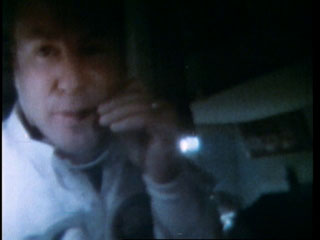
Jim Lovell wishes everyone a nice evening.
055:46:30 Lousma: Thank you, 13.
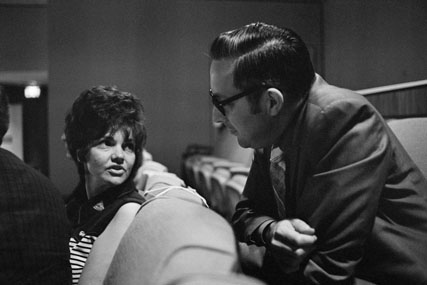
Marilyn Lovell, the wife of Jim, in the Mission Control VIP viewing area with Flight Doctor, Medical Director Charles A. Berry. The photo was taken minutes before the accident.


